Home Decor
Is Interior Decorating a Skill
Curious about whether interior decorating is a skill? Explore how creativity and practicality merge to transform spaces in surprising ways.

Interior decorating is indeed a valuable skill that melds creativity with practicality to transform spaces into both visually appealing and functional areas. It involves understanding design principles, client preferences, and effective project management. By mastering spatial awareness, color coordination, and attention to detail, decorators can create cohesive and inviting spaces. Developing these skills not only enhances living environments but also adds value to properties. If you're curious about the essential skills, impact of design principles, evolution of techniques, communication's role, and trends in interior decorating, there's more to discover in the detailed information provided.
Key Takeaways
- Interior decorating is a skill that involves understanding design principles.
- It requires mastering spatial awareness, color coordination, and decor selection.
- Strong project management skills are essential for successful execution.
- Communication plays a crucial role in translating clients' preferences into designs.
- It involves creatively curating decor items to transform living and work spaces.
Importance of Interior Decorating Skills
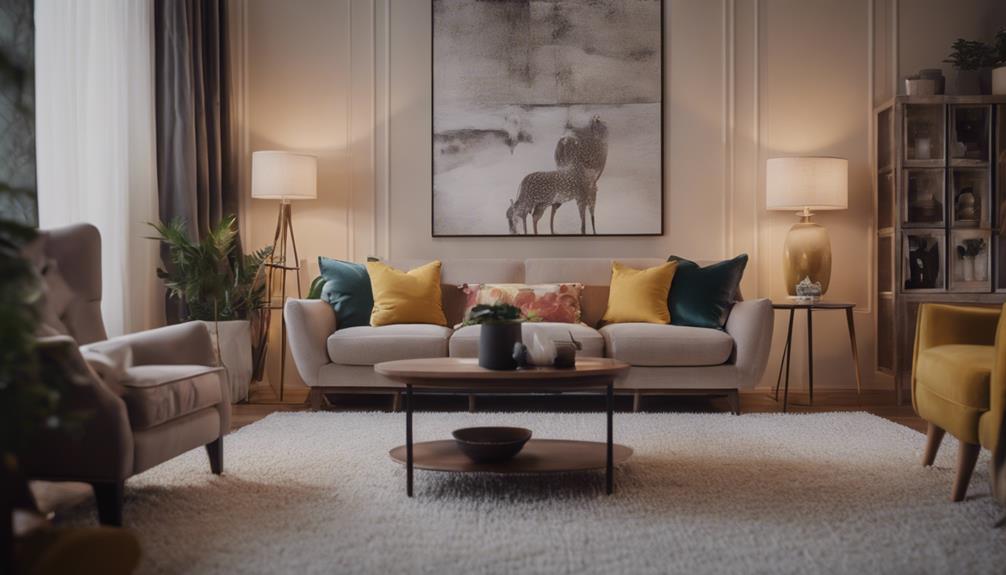
Interior decorating skills play a significant role in transforming living and work spaces by enhancing both their aesthetics and functionality. When it comes to interior design, honing our skills in understanding clients' preferences, project management, and design principles is essential. Working closely with clients allows us to create spaces that not only look visually appealing but also cater to their specific needs and lifestyle. Developing strong project management skills guarantees that our interior decorating projects are executed smoothly and efficiently, meeting deadlines and budget requirements.
In the domain of interior decorating, our skills in spatial awareness, color coordination, and design principles are what set us apart. By mastering these skills, we can create harmonious spaces that reflect the client's personality and style. Additionally, having a keen eye for detail and the ability to manage projects effectively are crucial for delivering successful interior design solutions. By continuously improving our interior decorating skills, we can elevate the aesthetics and functionality of any space we work on.
Key Elements of Interior Decorating
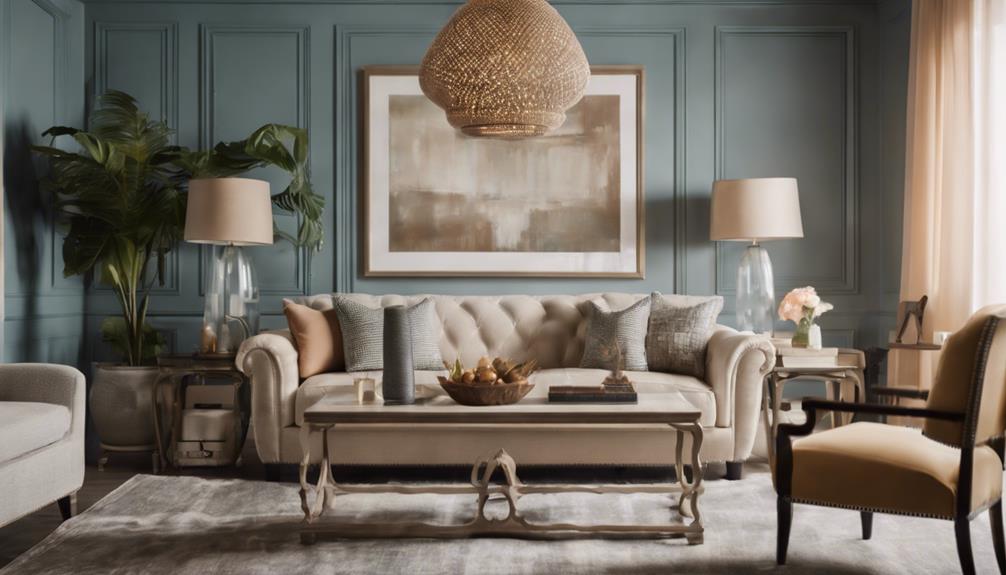
Exploring the world of interior decorating reveals a plethora of key elements that shape and enhance living and work spaces. Interior designers utilize a range of skills to transform rooms into functional and visually appealing environments. Attention to detail is paramount in this process, as every element contributes to the overall aesthetics of a space. Understanding color theory, texture, balance, and scale are essential skills that interior decorators must possess to create harmonious designs. By incorporating these elements effectively, decorators can elevate the look and feel of a room.
The design process followed by interior designers involves a systematic approach to curate decor items like furniture, accessories, and art. This process requires creativity and the ability to interpret and execute a client's vision. Interior decorators play an important role in improving the functionality and visual appeal of a room without the need for architectural knowledge. Their skills are crucial in selecting and coordinating decor elements to create inviting and cohesive living and workspaces.
Benefits of Developing Decorating Skills
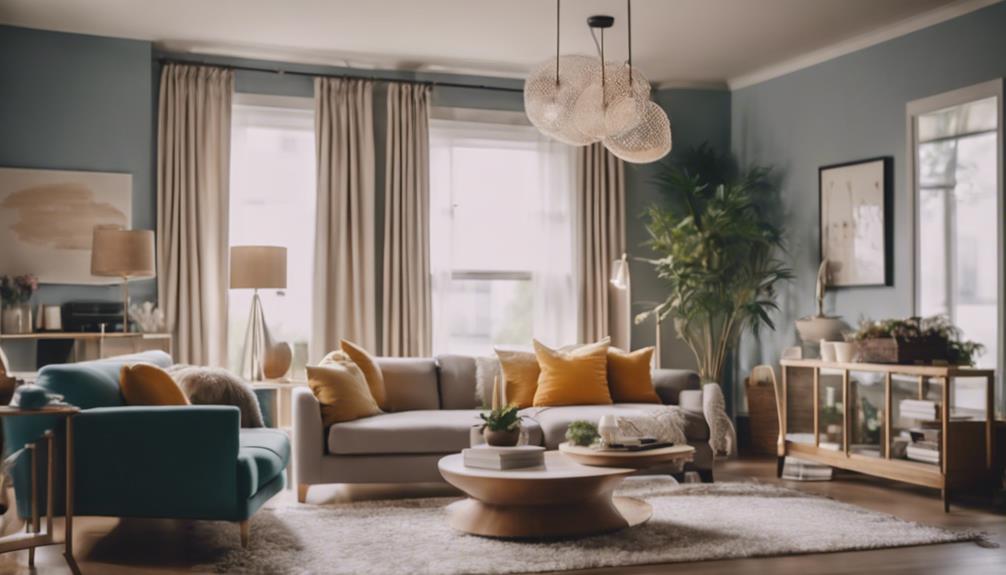
Developing decorating skills offers numerous benefits, including enhancing living spaces to create a more visually appealing environment. Personalizing home decor allows for a unique expression of individual style and preferences through the arrangement of furniture and accessories.
Boosting creativity and style through mastering decorating principles leads to more cohesive and aesthetically pleasing room designs.
Enhancing Living Spaces
Enhancing living spaces through the development of decorating skills offers a myriad of benefits, including the creation of visually appealing and functional environments. Interior designers with strong interior decorating and design skills can transform spaces into aesthetically pleasing areas that meet clients' needs.
By mastering these skills, individuals can personalize their living spaces to reflect their unique style and personality, making the environment more inviting and comfortable. Moreover, well-developed decorating skills can increase the value of a property by incorporating attractive design elements and enhancing overall aesthetics.
Learning how to decorate effectively also provides cost-effective ways to revamp spaces without the need for major renovations or structural changes. Ultimately, developing these skills can lead to the creation of harmonious and comfortable living environments tailored to individual preferences and needs.
Personalizing Home Decor
Personalizing our home decor through the development of decorating skills allows us to showcase our unique style and personality within our living spaces. Interior designers and decorators, along with other design professionals, emphasize the importance of personalizing home decor to create a space that truly reflects who we are.
By honing our decorating skills, we can arrange furniture, accessories, and color schemes in a way that not only looks visually appealing but also enhances our mood and productivity. Additionally, personalized home decor can contribute to our overall well-being.
Developing these skills helps us avoid costly mistakes and guarantees that our living space aligns with our tastes and preferences, saving both time and money in the long run.
Boosting Creativity and Style
Boosting creativity and style in interior decorating involves infusing living spaces with a unique and personalized touch that reflects individuality and aesthetic preferences. Interior designers who excel in this skill set often enhance their career in interior design by developing a strong design portfolio that showcases their ability to create visually appealing and harmonious room designs.
Understanding color theory is essential in mixing and matching textures, colors, and décor elements to achieve a cohesive look. Additionally, communication skills play a significant role in interpreting clients' needs and preferences to deliver personalized and customized living environments. By mastering decorating skills, one can elevate the overall appeal of a space, potentially increasing property value and attracting potential buyers.
Essential Skills for Interior Decorators
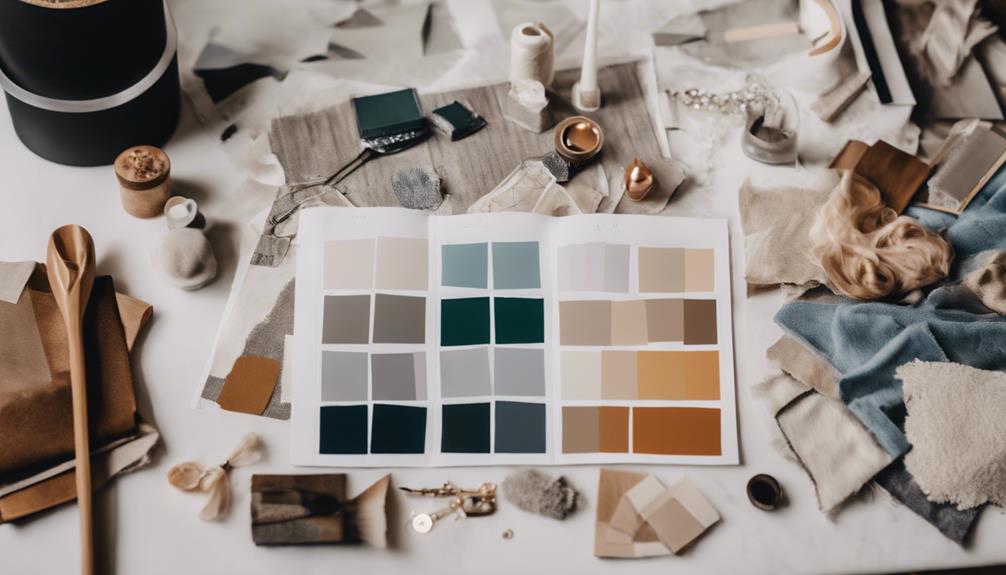
Interior decorators require a combination of skills in color coordination, spatial arrangement, and design principles to excel in their profession. These essential skills enable interior designers to create harmonious and visually appealing spaces for their clients. Here are the key skills needed for interior decorators:
- Color Coordination: Mastery of color theory and the ability to select and combine colors effectively to evoke the desired mood and atmosphere in a room.
- Spatial Arrangement: Understanding how to optimize the layout of furniture, decor, and functional elements within a space to enhance flow and functionality.
- Design Principles: Knowledge of fundamental design concepts such as balance, harmony, proportion, and scale to create well-balanced and aesthetically pleasing interiors.
Impact of Design Principles in Decorating
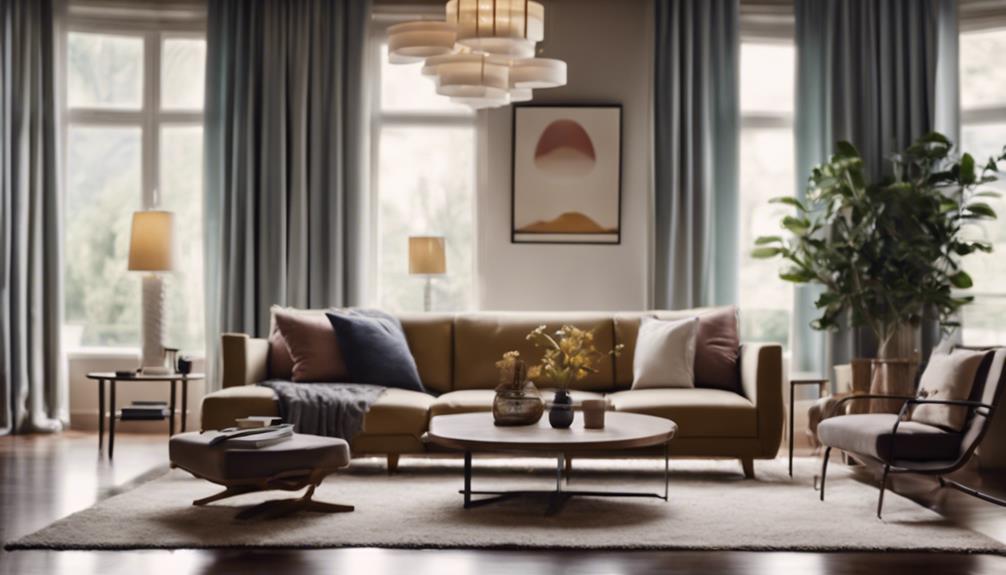
Design principles play a significant role in interior decorating by shaping the overall look and feel of a space.
Color psychology helps in creating specific atmospheres, while patterns add visual interest and personality.
Understanding spatial arrangement guarantees furniture and decor are placed harmoniously for a balanced and cohesive design.
Color Psychology in Design
Exploring the impact of color psychology on design principles in interior decorating reveals how different colors influence emotions, behaviors, and perceptions within a space. When considering color choices for interior decorating, it's essential to understand how each color can affect the overall feel of a room.
Here are key points to keep in mind:
- Emotional Influence: Colors evoke specific emotions; warm tones like red and yellow can energize a room, while cool shades like blue and green promote relaxation.
- Visual Impact: Using color theory to create contrast in schemes can add visual interest and highlight focal points in a space.
- Cultural Associations: Color choices in interior decorating are often influenced by cultural associations and personal preferences, shaping the atmosphere of a room.
Use of Patterns
Patterns in decorating play a significant role in adding visual interest and depth to a space, enhancing the overall aesthetic appeal.
When incorporating patterns into an interior decor scheme, understanding design principles such as balance and rhythm is essential. By mixing different patterns thoughtfully, you can achieve a dynamic yet cohesive look.
Keep in mind that patterns can influence how we perceive space; larger patterns create a cozy, intimate feel, while smaller patterns can make a room seem more spacious.
To create a well-balanced and visually appealing decor, harmonize patterns with other design elements like colors and textures.
Spatial Arrangement Importance
Incorporating design principles such as balance and rhythm in interior decorating greatly impacts the spatial arrangement of a room, enhancing both its functionality and aesthetic appeal.
When considering spatial arrangement, interior designers prioritize the following key aspects:
- Functionality: Design principles help optimize the layout of furniture and decor to guarantee efficient use of space and promote ease of movement within the room.
- Aesthetics: By applying principles like proportion and harmony, designers create visually pleasing arrangements that enhance the overall look and feel of the space.
- Coherence: Understanding the influence of design principles allows decorators to achieve a cohesive and well-balanced spatial arrangement, resulting in a harmonious environment that complements the room's purpose.
Evolution of Interior Decorating Techniques
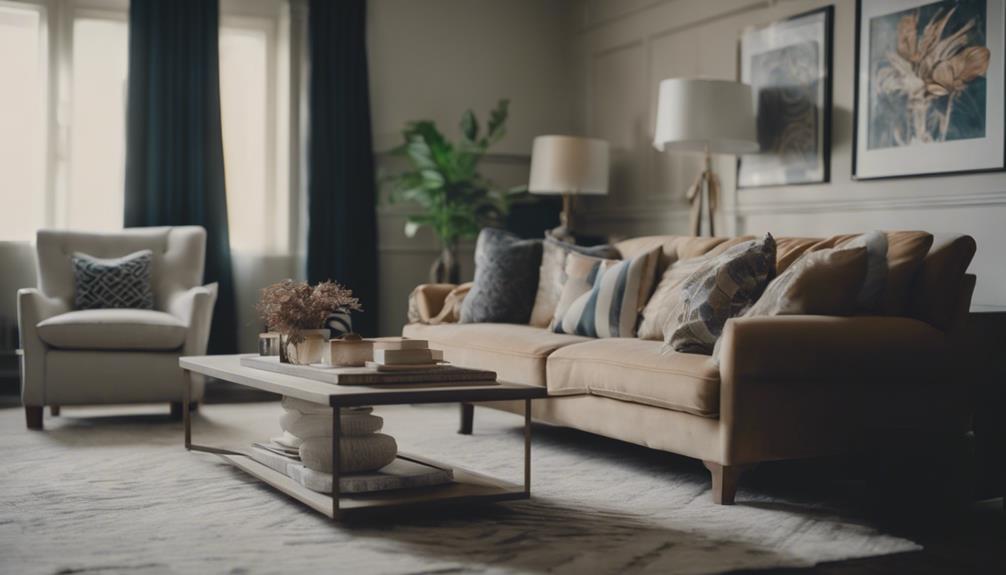
Over time, interior decorating techniques have evolved greatly, embracing new materials, styles, and methods to enhance living spaces. Historical interior decorating techniques have played a significant role in shaping the design field, blending traditional and contemporary elements to create unique and innovative spaces. The art and design principles from different time periods continue to influence modern interior decorators, inspiring them to create harmonious and aesthetically pleasing environments.
With the advent of computer-aided design (CAD) tools, interior designers now have access to advanced technology that allows for more precise planning and visualization of their ideas. This technological shift has revolutionized the way interior decorating is approached, enabling professionals to streamline their processes and bring concepts to life with greater efficiency.
Incorporating sustainable and eco-friendly practices has also become a prominent aspect of modern interior decorating techniques. Designers are increasingly focusing on using environmentally conscious materials and methods to create spaces that aren't only visually appealing but also sustainable for the long term. As the design field continues to evolve, interior decorators adapt their techniques to meet changing client preferences, industry standards, and design innovations.
Role of Communication in Decorating
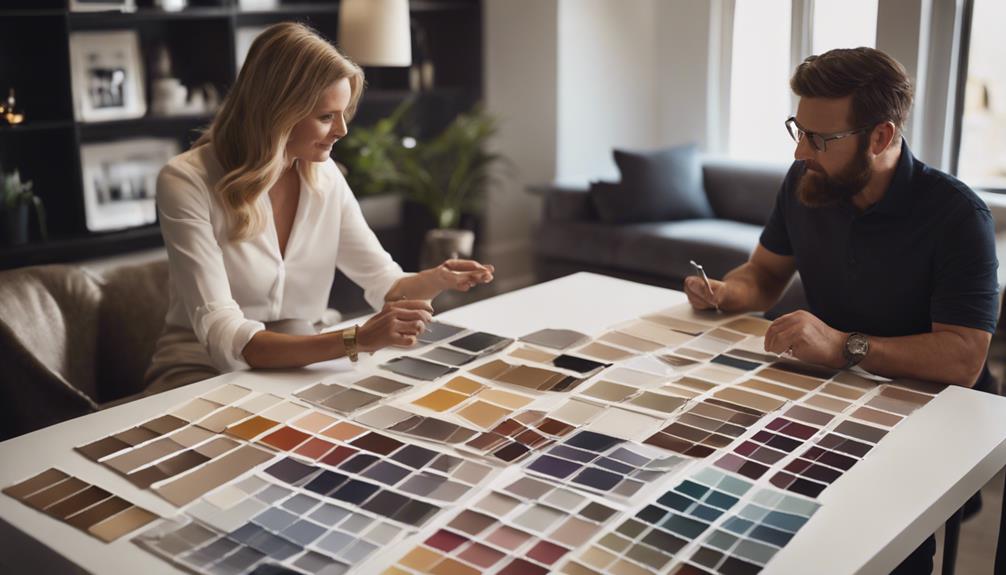
As interior decorating techniques continue to advance, effective communication remains a cornerstone in understanding clients' needs and translating design visions into successful projects. Communication plays an essential role in interior decorating by facilitating collaboration and ensuring that clients' preferences are accurately captured and reflected in the design process. Here are key points highlighting the significance of communication in decorating:
- Understanding Clients: Communication is crucial for decorators to comprehend clients' needs, preferences, and expectations, laying the foundation for a tailored design approach.
- Translating Design Ideas: Clear and concise communication enables decorators to convey design concepts accurately to clients and other professionals, ensuring everyone is on the same page throughout the project.
- Collaboration: Effective communication fosters seamless collaboration between decorators, contractors, suppliers, and vendors, leading to a cohesive and well-executed decorating process.
Implementing Trends in Interior Decorating
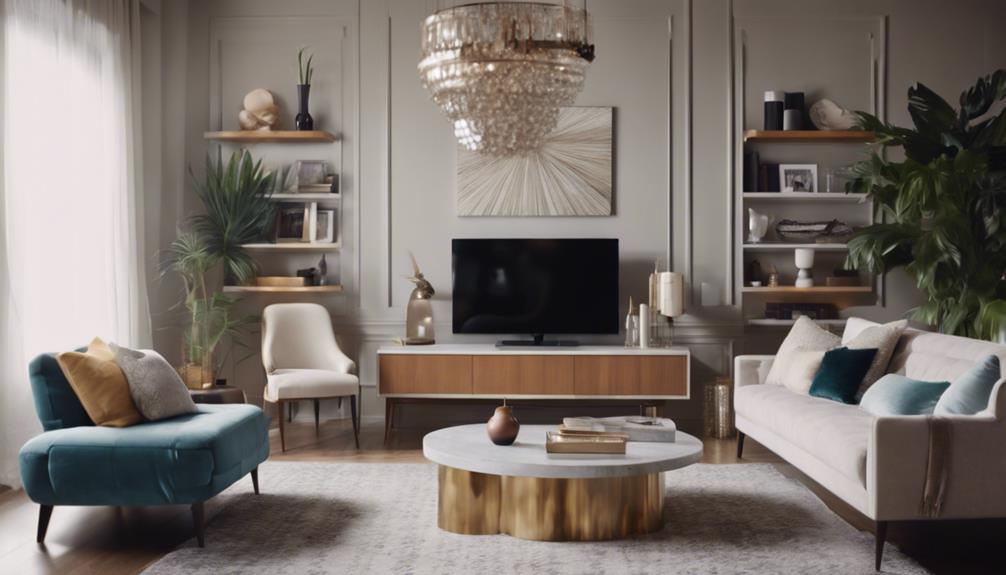
When implementing trends in interior decorating, we prioritize sustainability and eco-friendly design practices to promote environmental consciousness. Incorporating sustainable design elements not only benefits the environment but also enhances the overall aesthetics of a space. Smart home technology is another trend that can elevate interior decorating by adding convenience and functionality to living areas. By integrating minimalist and Scandinavian design principles, spaces can achieve a clean, uncluttered look that is both visually appealing and calming. Additionally, including biophilic design elements, such as natural light and indoor plants, can greatly improve the well-being of occupants by fostering a connection to nature within the space. Personalizing interior decorating projects allows for unique and tailored design solutions that reflect the individuality and preferences of clients.
| Trend | Description | Benefits |
|---|---|---|
| Sustainable Design | Focuses on eco-friendly practices and materials to promote environmental consciousness. | Enhances aesthetics and reduces environmental impact. |
| Smart Home Technology | Integrates technology to increase convenience and functionality in living spaces. | Improves efficiency and control over various home systems. |
| Minimalist Design | Emphasizes simplicity, clean lines, and a clutter-free environment for a visually appealing space. | Creates a calming and uncluttered atmosphere. |
| Scandinavian Design | Draws inspiration from Nordic countries, featuring simplicity, functionality, and natural elements. | Enhances natural light and creates a cozy, inviting ambiance. |
| Biophilic Design | Incorporates nature into interior spaces to improve well-being and connection to the natural world. | Enhances mental health and overall sense of tranquility within the space. |
Frequently Asked Questions
What's the Difference Between Interior Design and Interior Decorating?
Interior design involves a Bachelor's Degree in Fine Arts. Interior designers focus on commercial design, architectural systems, and building codes. Licensing requirements for interior designers often involve experience under a licensed professional.
Interior decorating typically requires an Associate's Degree in Interior Design. Interior decorators specialize in residential design and decor choices. The distinction lies in educational background, project scope, and industry knowledge.
Is Interior Decorating a Good Career?
Interior decorating can be a promising career path for individuals who appreciate design and aesthetics. It offers opportunities to enhance spaces, cater to client needs, and manage projects. With skills in CAD, design sense, and budget management, interior decorating can be a fulfilling profession.
The average salary of around $33,404 per year in the U.S. adds to its appeal. Overall, interior decorating presents a good career option for those inclined towards creative and practical work.
What Is Another Name for an Interior Decorator?
Another name for an interior decorator is an interior stylist or interior design consultant. This term highlights the focus on the aesthetic aspects of a space rather than the technical or structural components.
Interior decorators collaborate with clients to understand their preferences and vision for the space, working on enhancing visual appeal and functionality through decor and furnishings. They select and arrange furniture, accessories, colors, and textures to create a cohesive design.
Do You Need to Be Able to Draw to Be an Interior Decorator?
We don't necessarily need to be able to draw to be an interior decorator. While drawing skills can be beneficial for communicating ideas visually, in today's digital age, there are alternative tools like mood boards and design software.
Some decorators focus more on decor selection and arrangement rather than detailed drawing. Although clients may appreciate sketches, it's not always a strict requirement for the role.
Interior decorating encompasses various skills beyond drawing.
Conclusion
To sum up, interior decorating is indeed a valuable skill that can greatly enhance the aesthetics and functionality of a space. By mastering key elements such as color, texture, and balance, individuals can transform any room into a beautiful and harmonious environment.
For example, a recent study showed that homes with well-decorated interiors tend to sell faster and at higher prices than those without professional design touches. So, developing your decorating skills can truly make a difference in both personal and professional settings.
Home Decor
Blend Modern and Traditional Decor Like a Pro – Discover the Secrets!
Learn how to seamlessly blend modern and traditional decor for a stunning space that reflects your unique style—discover the secrets inside!
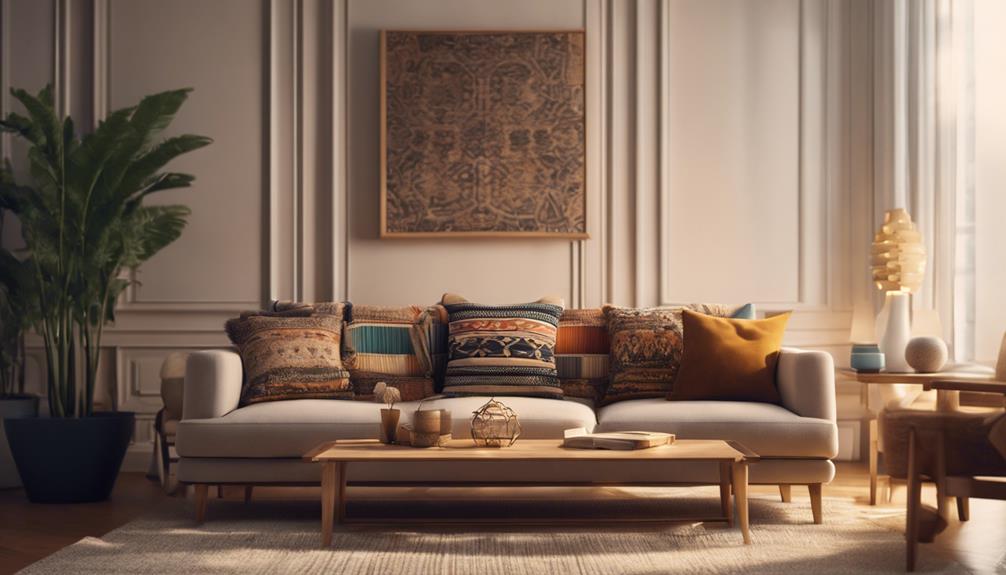
Blending modern and traditional decor is all about balance and intent. Start by selecting complementary furniture that enhances both styles, like a sleek modern coffee table paired with an ornate traditional sofa. Focus on a cohesive color palette to unify the look, and mix textures for a dynamic appeal. Choose art that bridges the gap between the two styles, ensuring it fits the context of your space. Don't forget about functional pieces, as they add purpose and charm. Discovering more techniques will elevate your decor game, making it just the kind of space you've always wanted!
Key Takeaways
- Combine sleek modern pieces with ornate traditional furniture to create aesthetic balance and visual contrast.
- Use a cohesive color palette and varied textures to seamlessly integrate modern and traditional styles.
- Select functional furniture that enhances usability while blending design elements from both styles.
- Incorporate art that bridges modern and traditional aesthetics for a harmonious visual appeal.
Understanding Furniture Styles
To create a harmonious space, you need to grasp the differences between modern, contemporary, and traditional furniture styles.
Modern furniture, emerging from the mid-20th century, showcases clean lines and functional design, often prioritizing simplicity and minimalism. Think of iconic pieces that reflect this era, like Eames chairs or sleek coffee tables.
In contrast, contemporary furniture lacks a definitive timeline and can sometimes feel bloated, incorporating trends that may not age well.
Traditional pieces, on the other hand, encompass historical styles such as Chippendale, Victorian, and Gustavian. These designs celebrate intricate details and craftsmanship, providing a sense of warmth and history to your decor. Understanding these distinctions is essential for blending styles effectively.
When you know the characteristics of modern furniture versus traditional pieces, you can create a balanced look that honors both aesthetics. For instance, pairing a sleek modern sofa with ornate traditional accent chairs can create a striking visual contrast that feels intentional rather than mismatched.
Techniques for Blending Decor
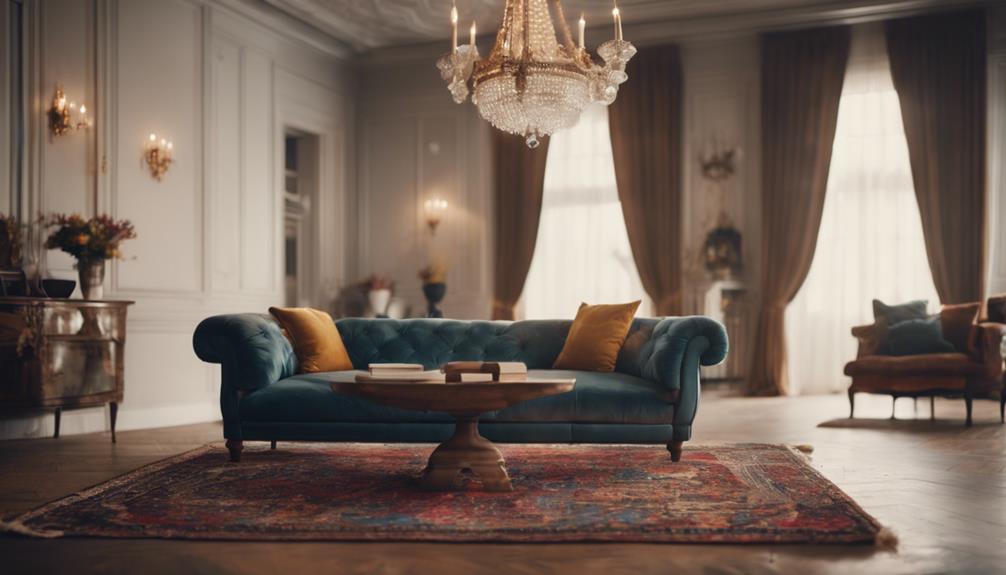
When blending modern and traditional decor, focus on choosing complementary furniture that enhances both styles.
Pay attention to color and texture harmony to create a seamless changeover between the two aesthetics.
With the right mix, you can achieve a space that feels balanced and inviting.
Complementary Furniture Choices
Blending modern and traditional decor calls for carefully selecting furniture that balances sleek lines with ornate details. A modern coffee table can serve as a versatile centerpiece, complementing traditional sofas and chairs while creating a harmonious blend of styles.
When mixing furniture, pair sleek, minimal modern pieces with more ornate traditional items to enhance aesthetic balance without overwhelming your space.
Consider incorporating contemporary accent pieces, like modern art or lighting fixtures, to elevate traditional settings and add a fresh touch. Functional furniture choices, such as modern side tables alongside traditional couches, create visual interest while keeping practicality in mind.
This approach not only enhances the overall design but also guarantees comfort and usability.
Color and Texture Harmony
Creating harmony between modern and traditional decor hinges on a cohesive color palette and a thoughtful mix of textures that complement each other seamlessly.
Start by selecting a color scheme that includes both modern and traditional hues, ensuring they work well together. This will create a smooth shift between styles.
To enhance the balance of color and texture in your space, consider these techniques:
- Choose a cohesive color palette that unites modern and traditional shades.
- Incorporate various textures by pairing sleek modern finishes with rich, traditional fabrics.
- Use area rugs that blend modern patterns with traditional designs to anchor the room.
- Select decorative pieces like cushions or throws featuring a mix of contemporary and classic patterns.
Key Elements for Integration
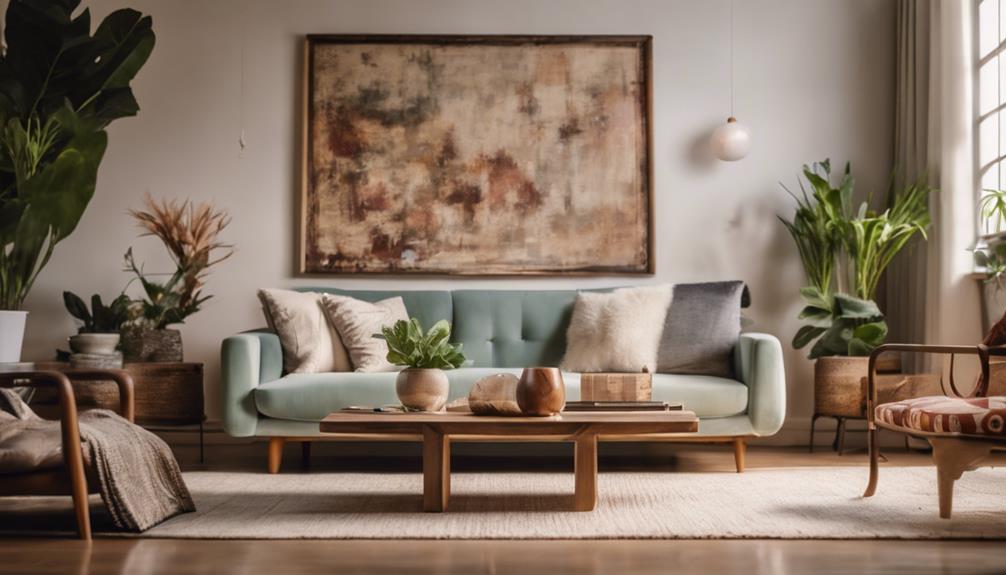
To successfully integrate modern and traditional decor, focus on finding complementary pieces that enhance the overall aesthetic without overwhelming the space.
Start by incorporating functional furniture that serves a purpose while adding style. For instance, a sleek modern coffee table can anchor your living room, harmonizing with classic sofas or armchairs.
Next, pay attention to your art selection. Choose pieces that bridge the gap between both styles, like abstract modern art alongside traditional landscapes. This combination adds depth and interest, creating a dynamic focal point that resonates with both aesthetics.
Maintaining an aesthetic balance is essential. Avoid overly stylized modern pieces that clash with traditional designs. Instead, aim for a cohesive color palette that ties everything together, ensuring that each element feels intentional.
Minimal decor can also help to integrate modern accents into traditional settings, promoting a unified look.
Architectural Context and Design
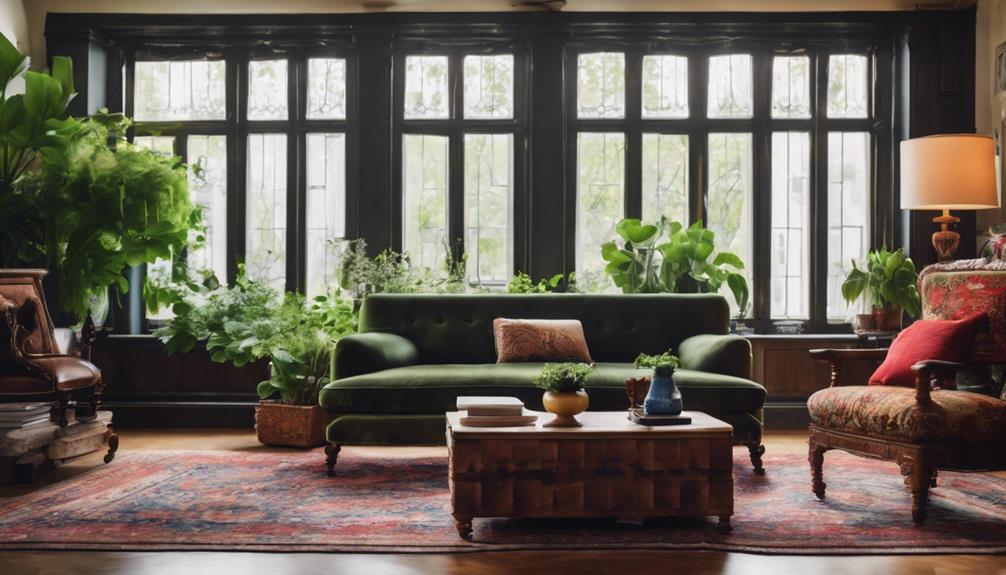
How does the architectural context of a space influence your choices when integrating modern and traditional decor? The features of a room, like high ceilings and ornate moldings, play a pivotal role in guiding your interior design decisions. When you understand the architectural context, you can seamlessly blend styles without overwhelming the space.
Here are some key considerations to keep in mind:
- Embrace traditional backdrops: Traditional architecture can beautifully showcase modern accents.
- Complement existing elements: Choose modern pieces that enhance, rather than compete with, traditional features.
- Avoid tackiness: In unique spaces like a 1960s ranch, verify modern selections align with the home's original design.
- Focus on cohesion: Aim for a harmonious coexistence of styles to maintain visual interest.
Shopping for Blended Styles
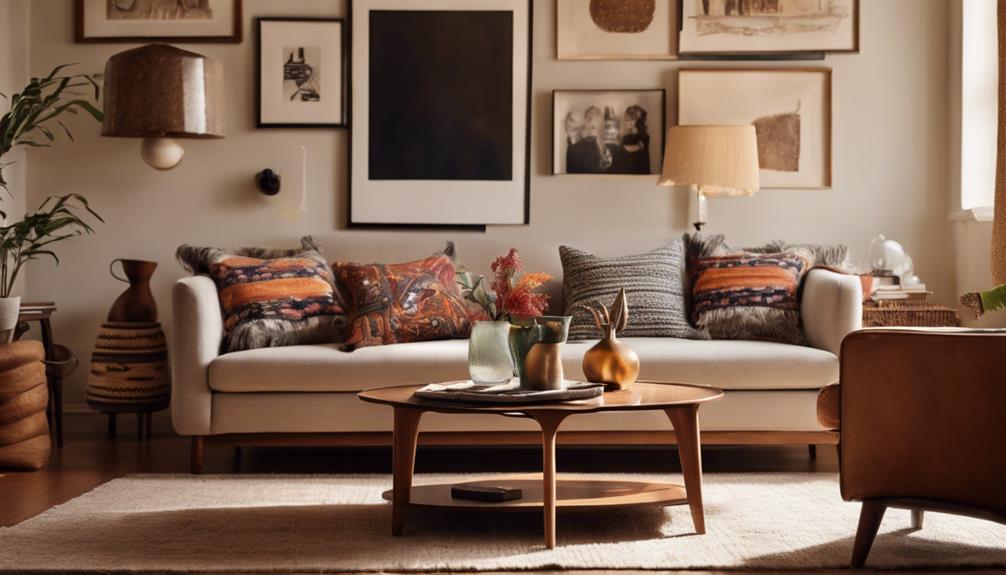
When you're shopping for blended styles, knowing where to look makes all the difference.
Retailers like Anthropologie and West Elm offer curated collections that seamlessly combine modern and traditional decor.
Plus, online shopping opens up a world of options, allowing you to find unique pieces that fit your aesthetic effortlessly.
Retailer Recommendations
Shopping for blended styles is a breeze with retailers like Anthropologie and West Elm, which offer curated collections that effortlessly mix modern and traditional decor.
You'll discover home furnishings that are mostly modern but include timeless elements to create a harmonious aesthetic in your space. Here are some recommendations to get you started:
- Explore Anthropologie's unique furniture and decor that features eclectic designs.
- Check out West Elm for sleek, contemporary pieces paired with classic accents.
- Consider wallpaper and wall murals from these retailers to unify your decor theme.
- Browse online shopping platforms for a variety of neutral and colorful options that allow for personalization.
These retailers not only provide a diverse range of options but also make it simple to find pieces that complement each other beautifully.
As you shop, keep in mind the balance between modern and traditional elements to achieve a cohesive look that reflects your personal style.
Enjoy the process of blending styles and creating a space that feels uniquely yours!
Online Shopping Tips
To successfully blend modern and traditional styles, start by exploring curated online collections that showcase unique pieces from retailers like Anthropologie and West Elm. These platforms offer a mix of furniture that can truly help your space look good. When online shopping, utilize filters to narrow down your search by style, color, and material, ensuring you find items that harmonize with both aesthetics.
Don't forget to check customer reviews and photos. They provide valuable insights into how various styles can work together in real-life settings, guiding your decisions. Additionally, consider the shipping and return policies of online stores. This way, you can make risk-free purchases and experiment with different furniture styles in your home without worry.
Engaging with design blogs and social media platforms can also offer tips and inspiration on blending modern and traditional decor effectively. You'll discover unique ideas and pieces that resonate with your vision.
With these online shopping tips, you'll be well-equipped to create a space that seamlessly combines both styles and ultimately looks good. Happy shopping!
Curated Collection Insights
Curated collections from retailers like Anthropologie and West Elm make it easy for you to discover pieces that seamlessly blend modern and traditional styles in your home. These collections offer a curated selection that allows you to find unique items while ensuring they harmonize with your existing decor.
Here are some insights to reflect on when shopping for blended styles:
- Look for furniture that features a mix of neutral and colorful tones.
- Explore wall murals and wallpaper to enhance your decor and tie themes together.
- Combine classic and modern fusion styles to create depth in your design.
- Pay attention to textures and materials that bridge the gap between traditional and contemporary.
With the right curated collection, you can elevate your home's aesthetic by incorporating traditional elements alongside modern pieces. By thoughtfully selecting items that complement each other, you'll create an eclectic and inviting atmosphere that reflects your personal style.
Inspiration From Eclectic Interiors
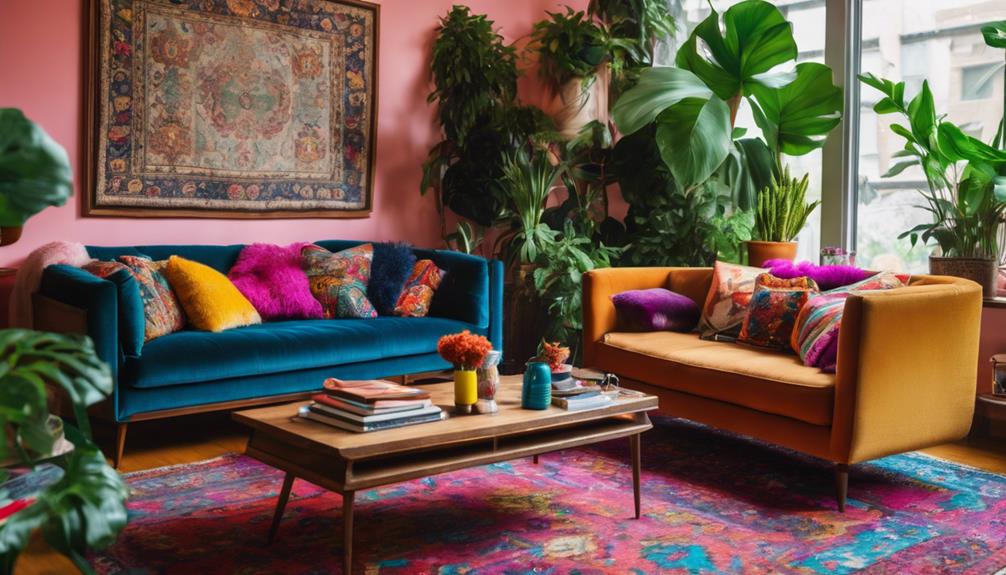
Exploring eclectic interiors reveals how seamlessly mid-century pieces can enhance traditional decor, offering endless inspiration for your home. By incorporating mid-century modern elements into a mostly traditional setting, you can create a unique aesthetic that captures attention and showcases your personality.
Consider how Scandinavian designs effectively showcase mid-century pieces alongside traditional elements. They emphasize simplicity and functionality, making them a perfect fit for various styles. Parisian interiors, on the other hand, highlight versatility by integrating mid-century cabinets with modern furnishings, proving that mixing styles can be both practical and visually appealing.
To illustrate the balance of these styles, take a look at the table below:
| Style Element | Description |
|---|---|
| Mid-Century Chairs | Lighter, sculptural designs |
| Traditional Furniture | Heavier, classic pieces |
| Color Palette | Consistent tones to unify the space |
| Placement Strategy | Pairing lighter items with heavier ones |
This thoughtful placement can elevate your room's atmosphere and create a sense of balance. Embrace these eclectic inspirations to transform your space into a harmonious blend of modern and traditional decor.
Essential Pieces for Harmony
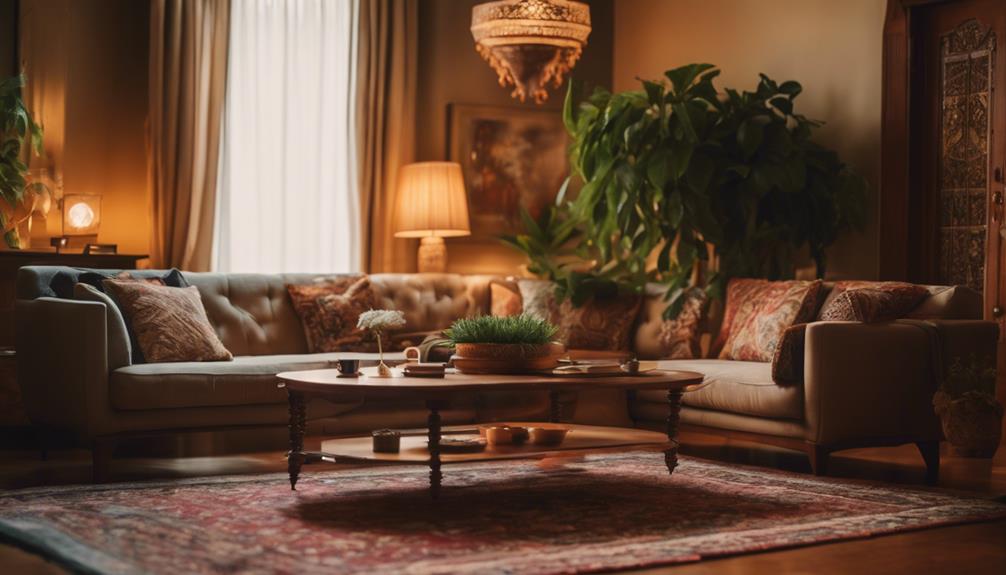
Finding the right essential pieces is key to achieving harmony between modern and traditional decor in your home. These elements can bridge the gap between styles, creating a cohesive and inviting look.
Here are some must-have pieces to contemplate:
- Mid-century chairs: They can enliven traditional spaces with their visual contrast and modern flair.
- Noguchi coffee table: This sculptural focal point harmonizes beautifully with both modern and traditional furnishings.
- Functional modern side tables: Placing these alongside traditional pieces maintains practicality while blending styles.
- Rugs: Use rugs like oriental or natural fibers to unify various furniture styles and define your spaces.
Creating Timeless Spaces
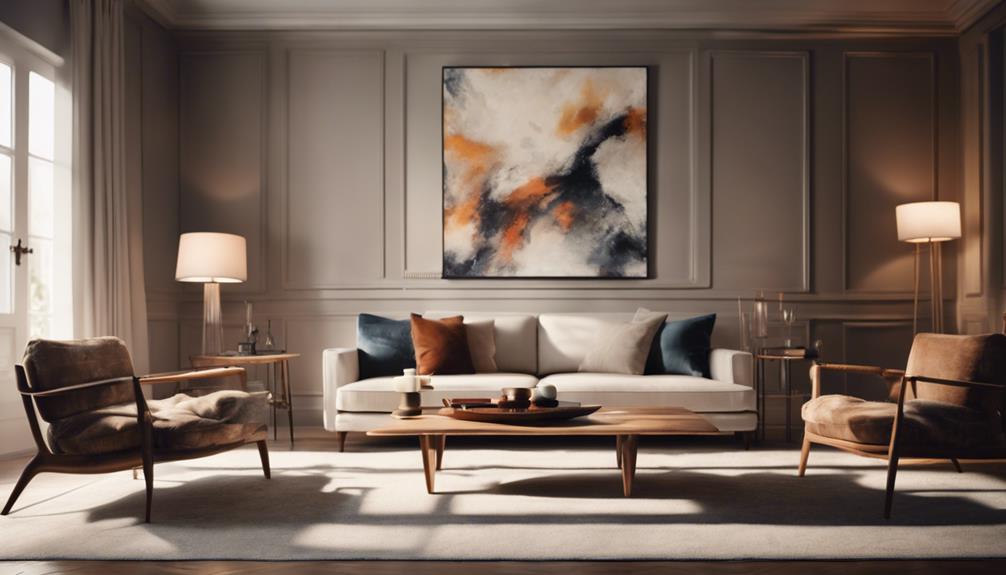
Creating timeless spaces involves skillfully blending modern and traditional elements to achieve a harmonious and inviting atmosphere.
Start by selecting functional furniture that reflects both styles; for instance, pair modern side tables with traditional sofas. This combination not only looks great but also serves a practical purpose.
Aesthetic balance is essential, so opt for complementary pieces. A modern coffee table can beautifully contrast with traditional chairs, unifying your room's design.
Don't underestimate the power of color schemes; using neutral palettes helps connect modern and traditional elements while enhancing sophistication.
Thoughtful art placement can also elevate your space. Consider mixing abstract pieces with traditional portraits to boost visual interest without overwhelming the room.
Frequently Asked Questions
How to Blend Traditional and Modern Decor?
To blend traditional and modern decor, mix complementary pieces, like a sleek coffee table with classic sofas. Use a balanced color scheme, and incorporate functional furniture and decorative accents to create a cohesive, inviting space.
What Is the Combination of Traditional and Modern Design Called?
When you mix Victorian furniture with sleek mid-century modern accents, you're creating an eclectic design. This combination harmonizes different styles, allowing your space to reflect unique personal tastes while maintaining a cohesive look.
How to Combine Traditional and Modern Architecture?
To combine traditional and modern architecture, focus on architectural features, use contrasting materials, and incorporate large windows for light. Balance outdoor spaces with modern landscaping to create a cohesive, inviting environment that harmonizes both styles.
How to Mix Traditional and Modern Art?
Think of a dance between eras; when mixing traditional and modern art, balance is key. Use color harmonies, mix framed and unframed pieces, and position art near traditional furniture for an enchanting, cohesive look.
Conclusion
By weaving together modern and traditional decor, you can create a tapestry of style that dances across your space.
Embrace the beauty of contrast, where sleek lines meet vintage charm, and let each piece tell its story.
As you blend these elements, you're not just decorating; you're crafting an experience that feels both fresh and timeless.
So go ahead, release your creativity, and watch your home transform into a harmonious haven that reflects your unique personality!
Home Decor
Must-Have Home Accents for August – Don’t Miss These Essentials!
Find out how these essential home accents can transform your space this August and elevate your style to the next level!
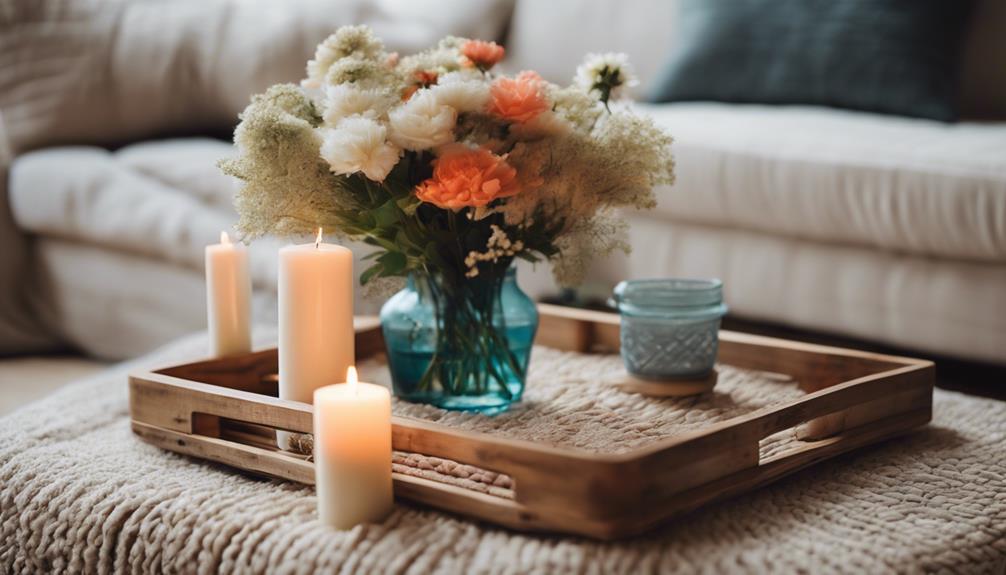
August is the perfect time to refresh your home with must-have accents. Start by elevating your walls with striking art that showcases your personality. Cozy throw pillows add texture and comfort to any space. A stylish coffee table not only acts as a centerpiece but also invites conversation. Don't forget a vibrant rug to warm up floors and create a cozy atmosphere. Brighten your rooms with unique lighting fixtures, and bring life indoors with low-maintenance plants. Finally, enhance your dining experience with chic tabletop decor. Keep going to find even more fabulous ideas that will transform your home.
Key Takeaways
- Incorporate vibrant wall art to enhance aesthetics and reflect personal style in your home this August.
- Refresh your living space with seasonal throw pillows that offer rich colors and varied textures for added comfort.
- Use stylish coffee tables as functional centerpieces that encourage social interactions and allow for decorative layering.
- Transform your interiors with rugs that define spaces and add warmth, available in diverse styles for every room.
Elevate Your Walls With Art
To truly elevate your walls, regularly incorporating enchanting wall art can dramatically transform your space and reflect your unique style. Wall art serves as a mood lifter, enhancing the aesthetic of your home while showcasing your personality.
Whether you prefer abstract pieces, serene landscapes, or quirky prints, there's a style that'll resonate with your taste and fit seamlessly into your decor items. Choosing art that complements your existing decor can help you maintain a cohesive look, accommodating various home decor trends.
Think about how each piece interacts with your furniture and color scheme—this way, your walls become engaging conversation starters for guests. Strategically placing artwork can enhance the visual interest of a room.
For instance, a large canvas above your sofa can draw the eye and create depth, while smaller pieces can be clustered together for an eclectic feel. Don't shy away from mixing sizes and styles; it can add a dynamic flair to your living space.
Cozy up With Throw Pillows
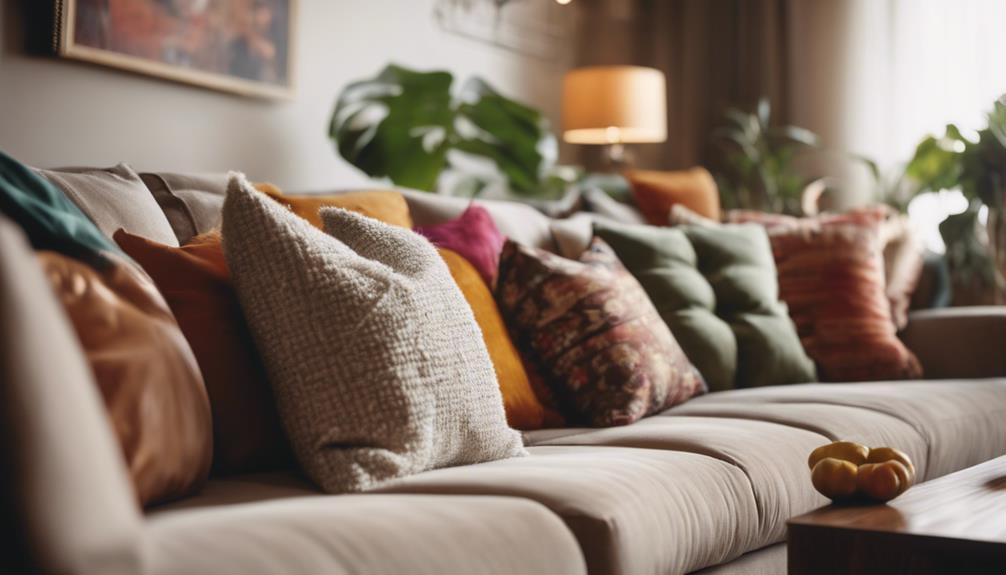
Throw pillows are your secret weapon for adding color and texture to any room.
You can easily swap them out with the seasons or layer different sizes and shapes for maximum comfort.
Let's explore how these simple accents can transform your space into a cozy retreat.
Color and Texture Options
Cozy up your space with a variety of throw pillows that showcase an array of colors, patterns, and textures. Throw pillows are perfect for adding warmth and dimension, making your living areas feel inviting and stylish. Consider opting for plush or patterned pillows to enhance the overall aesthetic.
For a fresh summer vibe, embrace vibrant colors that can brighten your interiors. These bold hues can serve as eye-catching focal points, drawing attention and creating a lively atmosphere. On the other hand, soft, neutral tones provide versatility for seasonal updates, allowing you to easily refresh your decor.
Layering different sizes and textures of throw pillows also enhances comfort while creating visual interest. Mix and match various patterns to curate a unique look that reflects your personal style. Plus, regularly swapping out pillow covers is a budget-friendly way to express your evolving tastes throughout the year.
Seasonal Swap Ideas
As summer winds down, swapping out your throw pillows for rich, warm colors can instantly bring a touch of fall into your home. Think deep oranges, burgundies, and earthy browns to set the cozy vibe for August. By adding color through your throw pillows, you can create an inviting atmosphere that reflects the changing season.
Don't just stick to one texture; mix it up! Combining velvet and knit pillows not only enhances comfort but also adds visual interest to your living spaces. Seasonal pillows featuring autumn-themed patterns—like leaves or pumpkins—serve as delightful accents that celebrate this shift.
Larger throw pillows can provide extra comfort and support, making your couches and beds more inviting for those cooler evenings. Feel free to play with sizes and shapes too. A dynamic mix of square, rectangular, and round throw pillows can create a layered look that's both stylish and welcoming.
Layering for Comfort
Enhance your living space by layering throw pillows in various textures and colors to create a warm and inviting atmosphere.
Throw pillows are an affordable way to introduce style and comfort into your home, and they allow you to easily refresh your decor as seasons change. By mixing different colors, patterns, and sizes, you can add visual interest and a cozy vibe to any room.
Consider these three essential tips for layering for comfort:
- Choose a Color Palette: Opt for a cohesive color scheme that reflects your personal style and complements your existing decor.
- Mix Textures: Combine soft fabrics like velvet with woven materials to create a dynamic and inviting look.
- Swap Seasonal Covers: Use neutral-colored pillow covers for year-round versatility, making it simple to switch out designs as the seasons change.
With these strategies, you can effortlessly elevate your space.
Don't forget, reusing pillow inserts while only purchasing new covers maximizes savings and keeps your decor fresh.
Functional and Stylish Coffee Tables
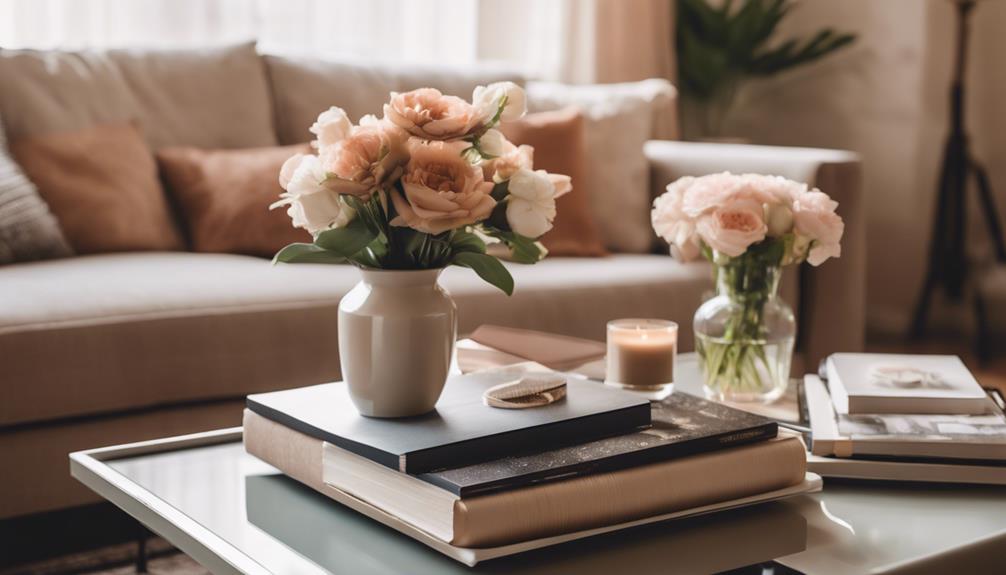
When you choose a coffee table, think of it as more than just a surface; it's a decorative centerpiece that enhances your living space.
It's also the perfect spot for social interactions, where friends gather and enjoy drinks while protecting your floors with coasters.
Plus, with designs that offer both style and storage, you can keep your space organized without sacrificing aesthetics.
Decorative Centerpiece Ideas
A stylish coffee table can transform your living space into a welcoming haven, seamlessly blending functionality with decorative flair. By implementing some thoughtful decorative centerpiece ideas, you can create a focal point that not only serves a purpose but also elevates your decor.
Here are three decor must-haves to contemplate:
- Layered Textures: Combine stacked coffee table books with a statement vase or unique bowl. This mix of height and texture creates visual interest and maintains a clean, inviting look.
- Seasonal Touches: Rotate in fresh flowers or seasonal fruits for a centerpiece that feels alive and ever-changing. This simple addition keeps your space fresh and inviting.
- Stylish Protection: Use coasters that complement your decor theme. They not only protect your table's surface but also add an extra layer of style to your centerpiece.
Enhancing Social Interactions
Creating a stylish coffee table not only amps up your decor but also sets the stage for memorable social interactions among friends and family.
A well-styled coffee table serves as a functional centerpiece that invites conversation, encouraging guests to gather around and engage. Incorporate decorative elements like bowls, books, and vases on your coffee table to enhance its aesthetics and provide interesting talking points.
Choosing a coffee table with ample surface area allows for easy placement of snacks and drinks, making it convenient for entertaining. This way, everyone feels comfortable while mingling. Regularly updating the decor—like adding seasonal items or personal treasures—keeps the space fresh and visually appealing for both you and your guests.
Additionally, utilizing coasters and trays adds an organizational flair to your coffee table, blending style with practicality. This contributes to a welcoming atmosphere that's perfect for socializing.
Practical Surface Protection
Protecting your coffee table's surface is essential for maintaining its beauty and functionality while complementing your home's style. A stylish coffee table not only serves as a functional centerpiece but also enhances your home decor essentials.
Here are three practical surface protection tips to keep your table looking great:
- Use Coasters: Always place coasters under drinks to prevent scratches and unsightly water rings. This simple habit can make a world of difference.
- Choose Durable Materials: Opt for coffee tables made from tempered glass or solid wood. These materials are resilient, ensuring your table withstands everyday use in high-traffic areas.
- Consider Multi-Functional Designs: Select a coffee table with storage compartments or lift-top features. These designs not only add practicality but also help keep your living space organized and clutter-free.
Transform Spaces With Rugs
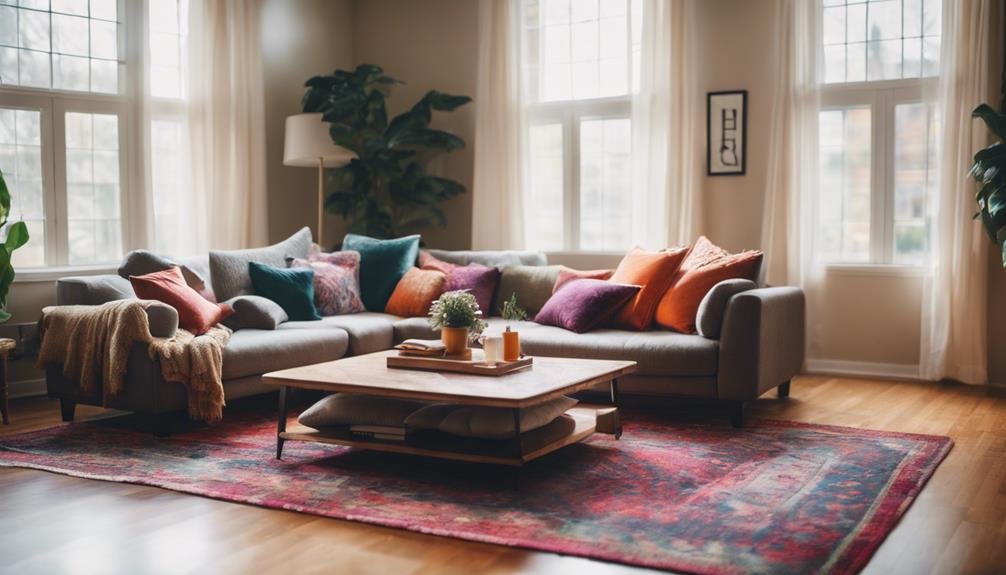
Rugs can instantly alter your spaces by adding color, texture, and warmth, making them essential elements of home decor. When you choose the right rug, it serves as a focal point that anchors your room, enhancing the overall aesthetics. With various patterns and materials available, you can define areas within open floor plans, creating distinct zones that guide the eye and enhance functionality.
Consider layering rugs for added warmth and style. This approach allows you to combine different textures and designs, showcasing your creativity. Additionally, indoor/outdoor rugs offer versatility, seamlessly changing between spaces and enhancing both your indoor and outdoor areas.
Here's a quick guide to help you choose the perfect rug for your home:
| Rug Type | Color Options | Ideal Space |
|---|---|---|
| Area Rugs | Bold, Neutral | Living Room |
| Runner Rugs | Bright, Subtle | Hallways |
| Outdoor Rugs | Vibrant, Earthy | Patios & Decks |
| Shag Rugs | Soft Pastels | Bedrooms |
| Vintage Rugs | Rich Patterns | Dining Areas |
A well-chosen rug can greatly impact your room's ambiance, making it cozy and inviting for relaxation and social interaction.
Add Charm With Decorative Accents
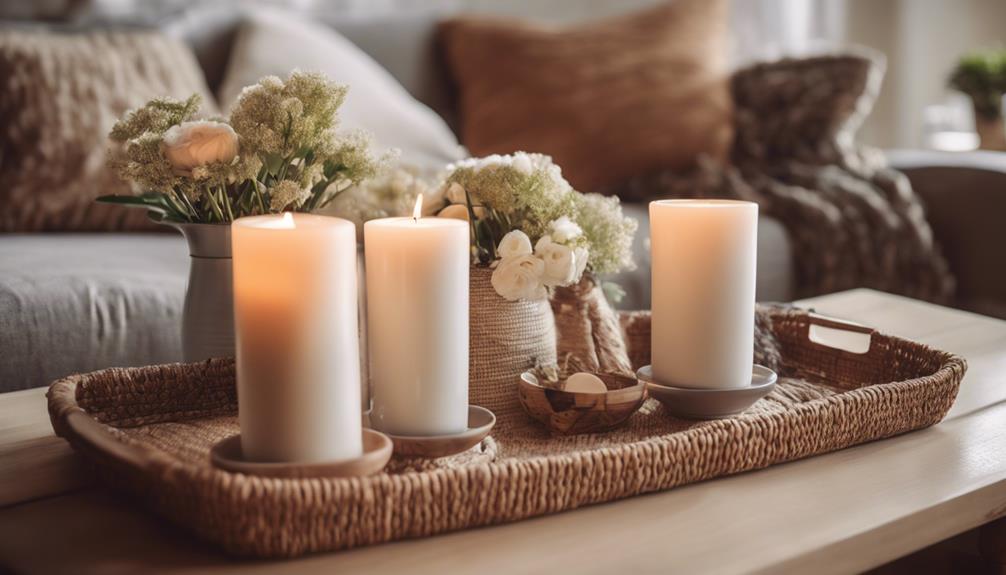
Adding decorative accents can instantly elevate your home's charm, showcasing your personal style and enhancing visual interest in every room. Whether you're looking to refresh your space or make a bold statement, these accents are essential for transforming your decor.
Here are three must-have decorative accents to contemplate:
- Mirrors: They not only create an illusion of space but also reflect light, making your room feel airier and brighter.
- Unique Bowls: These can serve as functional decor on tables or shelves, adding a touch of elegance while acting as conversation starters for your guests.
- Vases: Filled with seasonal blooms, vases bring life and color to your spaces, enhancing the overall aesthetic appeal of your home.
Incorporating decorative accents allows for easy updates to your decor, making it simple to adjust your home's vibe with the changing seasons. By choosing a curated selection of items, you can add layers of texture and character, creating focal points that draw the eye.
Stay Warm With Throw Blankets
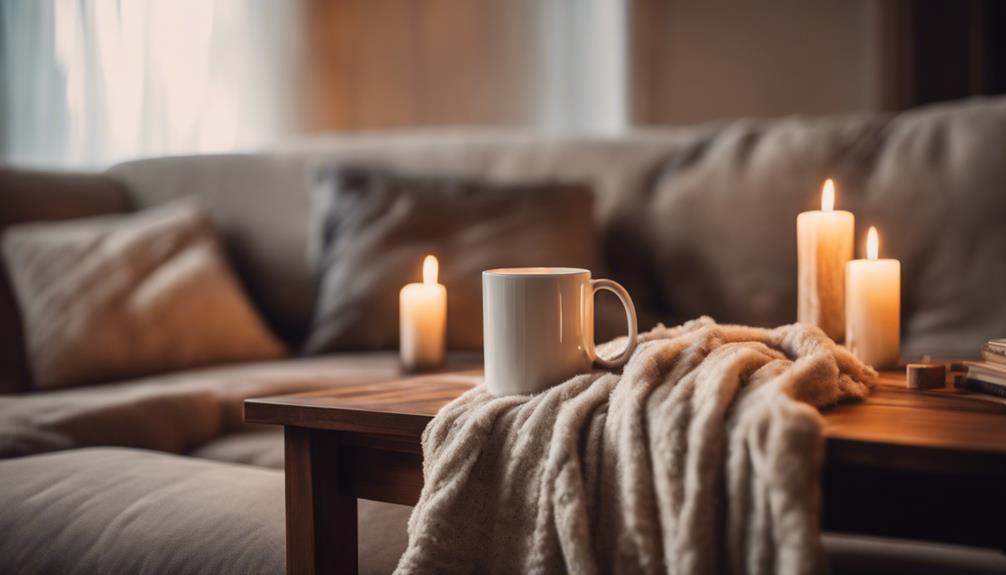
Throw blankets are your go-to solution for staying cozy as summer nights grow cooler and the fall season approaches. These versatile essentials not only provide warmth but also add a touch of style to your home. Available in various materials like cotton, wool, and knit, you can choose lightweight options that allow for easy layering without overheating during those warmer August days.
You'll love how throw blankets come in a wide array of colors and patterns, making it simple to integrate them into your existing decor. Drape them over your sofa, chair, or bed to create an inviting atmosphere perfect for cozying up with a book or enjoying a movie night with family and friends. They enhance visual interest and offer a quick way to refresh your space.
Best of all, throw blankets are budget-friendly and can be easily swapped out with the seasons. This means you can enjoy a new look without breaking the bank. So, invest in a few stylish throw blankets this August, and make your home a warm and welcoming haven as the weather shifts.
Brighten up With Lighting
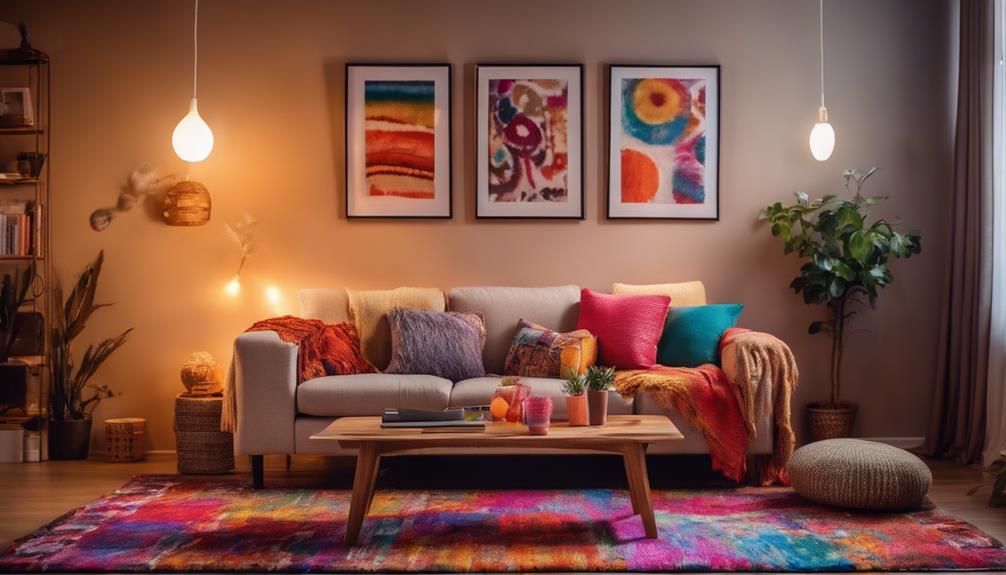
Brightening up your home with the right lighting can greatly boost your mood and enhance your decor.
By choosing energy-efficient options, you not only save on bills but also contribute to a greener planet.
Let's explore how mood-boosting fixtures and smart lighting choices can transform your space.
Mood-Boosting Light Fixtures
Mood-boosting light fixtures transform your space by combining functional and decorative elements that enhance the overall ambiance.
Whether you're looking to create a warm, inviting atmosphere or a bright, energetic vibe, the right lighting can make all the difference. Consider adding stylish floor lamps that not only illuminate but also serve as eye-catching decor pieces.
Here are three must-have mood-boosting lighting options to elevate your home:
- Adjustable Floor Lamps: These versatile fixtures allow you to change the intensity of light, helping you switch from vibrant to cozy in an instant.
- Unique Pendant Lights: Make a statement with pendant lighting that highlights your personal style while casting a soft glow across the room.
- Accent Lighting: Use lighting to draw attention to artwork or architectural features, adding depth and interest to your decor.
Energy-Efficient Lighting Options
If you're looking to reduce your energy bills while still illuminating your home beautifully, energy-efficient lighting options are the perfect solution. Switching to LED bulbs can save you up to 75% on energy costs compared to traditional incandescent bulbs. Plus, these bulbs have an impressive lifespan of up to 25,000 hours, far outlasting the standard 1,000-hour lifespan of incandescent bulbs.
When you choose Energy Star-rated lighting products, you're investing in high efficiency and performance that meet strict energy-saving guidelines. Consider adding dimmable LED and CFL bulbs to enhance your home feel while allowing you to adjust the light levels for different moods and activities. This flexibility can lead to even more energy savings.
Smart lighting systems are another fantastic option. They let you control lighting schedules and intensity remotely, which optimizes energy use and adds convenience to your life.
Bring Life With Indoor Plants
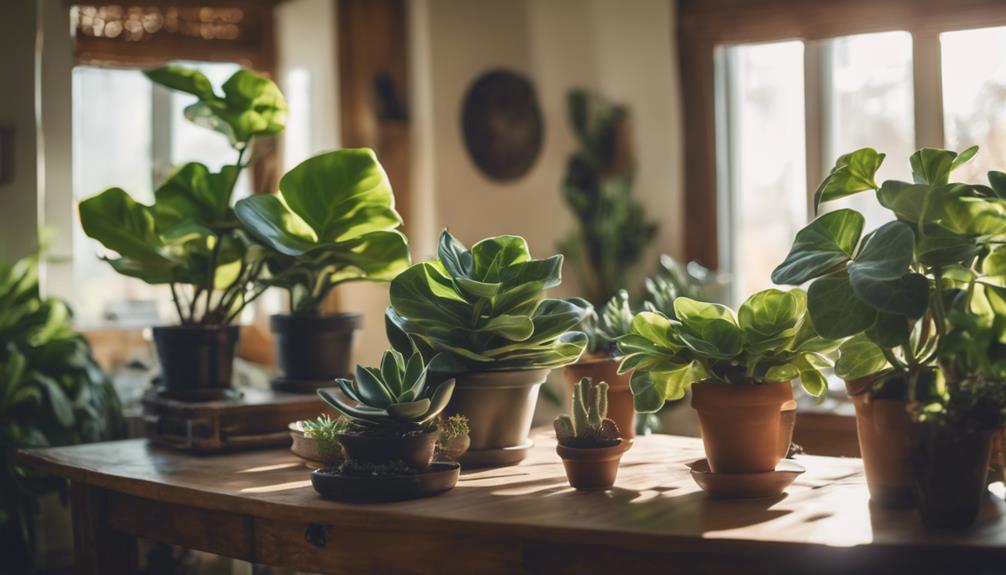
Indoor plants breathe life into your home, enhancing both aesthetics and air quality while creating a serene atmosphere. By introducing greenery, you not only beautify your space but also boost your well-being. Here are three compelling reasons to bring life with indoor plants:
- Air Quality Improvement: Indoor plants like pothos and snake plants filter toxins, increasing oxygen levels and creating a healthier environment.
- Stress Reduction: Studies show that having greenery around you can lower stress levels, promoting a calming and peaceful ambiance.
- Low-Maintenance Options: If you're new to gardening, consider succulents or ZZ plants. They require minimal care while still adding vibrant life to your space.
Strategically placing your indoor plants in awkward corners or bare areas can transform your home into a sanctuary.
Plus, choosing pots and planters in various materials and colors allows you to express your personal style while adding texture.
Frame Views With Curtains
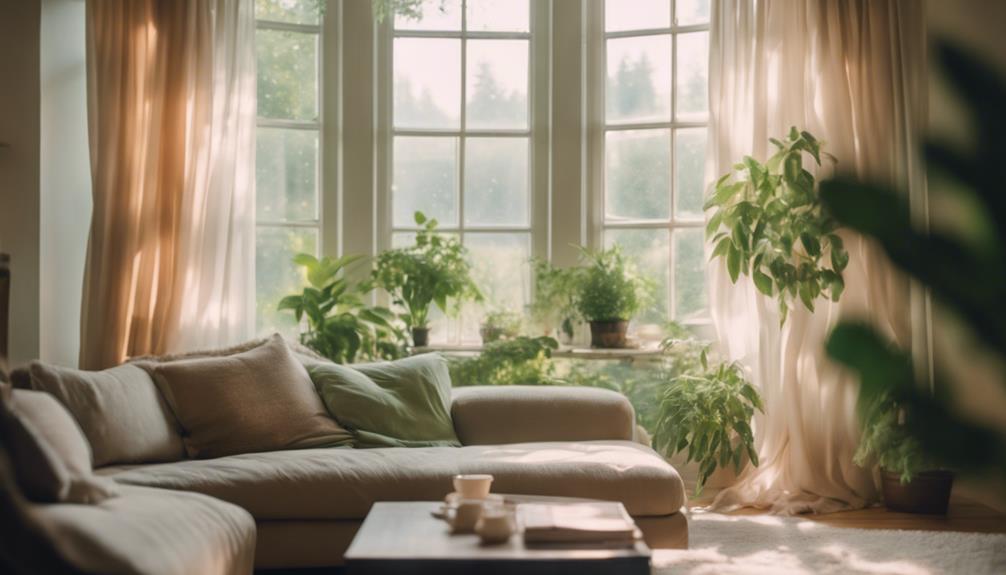
Curtains beautifully frame your windows, enhancing the views while adding elegance and sophistication to your home. With a wide variety of styles available, from sheer to bold patterned designs, you can express your personal style and complement your existing decor. Think about how these fabrics interact with your color palette; the right choice can create a cohesive look throughout your space.
When selecting curtains, consider how they control light and privacy. You can adjust them to set the perfect ambiance in your rooms, whether you want bright sunlight or a cozy, dim atmosphere. Properly hung curtains can also give the illusion of higher ceilings, making your space feel larger and more open.
Don't forget to coordinate your curtains with other accents in the room, such as decorative pillows. This thoughtful pairing can tie the entire look together, creating a harmonious feel. Take your time to choose the best fabrics and colors, as these details can greatly impact your home's overall aesthetic.
With the right curtains, you'll not only frame your views but also elevate your living space to new heights of style and comfort.
Enhance Dining With Tabletop Decor
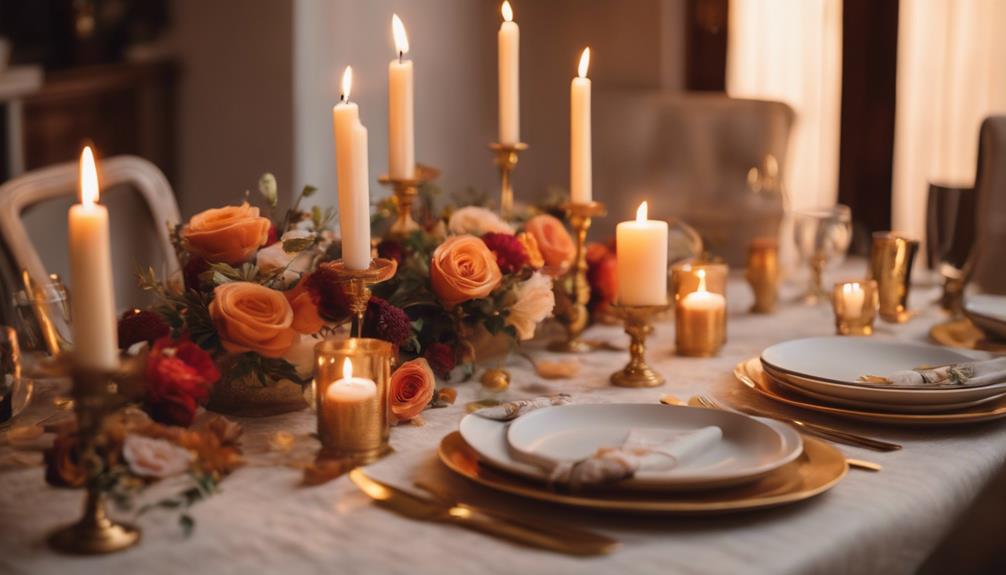
Transforming your dining experience starts with thoughtfully curated tabletop decor that reflects your personal style and invites conversation. By incorporating vibrant elements, you can create a warm and engaging atmosphere that enhances every meal.
Here are three must-have items to elevate your tabletop decor:
- Stylish Placemats: Add a pop of color to your table with unique placemats that set the tone for your dining experience. They can easily shift from room to room, making them versatile and stylish.
- Elegant Dinnerware: Choose dinnerware that showcases your taste—opt for patterns or colors that resonate with your theme. Quality pieces not only enhance functionality but also serve as conversation starters.
- Eye-Catching Centerpieces: Fresh flowers or themed decorations can transform your table into a focal point. Seasonal updates keep the decor fresh and engaging, drawing guests in.
Frequently Asked Questions
What Season to Decorate in August?
In August, you should decorate for the shift between summer and fall. Embrace bright summer colors while gradually introducing autumn tones, creating a warm, inviting atmosphere that prepares your home for the upcoming season.
What Defines Home Décor Accents?
Did you know that 75% of people believe home decor reflects their personality? Home decor accents define your space's style, enhancing aesthetics with items like vases and art, creating focal points, and adding inviting textures and colors.
Conclusion
To wrap up, these must-have home accents for August can truly transform your space into a cozy haven.
Did you know that adding just a few decorative elements can increase your home's perceived value by up to 10%? So, don't underestimate the power of well-chosen accents!
Embrace your personal style with art, plants, and lighting, and watch your home come alive.
Go ahead, make these changes and enjoy the inviting atmosphere you create!
Home Decor
Floral Vs. Plaid: Which Is Better for Your Country Living Room?
Overwhelmed by the choice between floral and plaid for your country living room? Discover which pattern will truly transform your space!
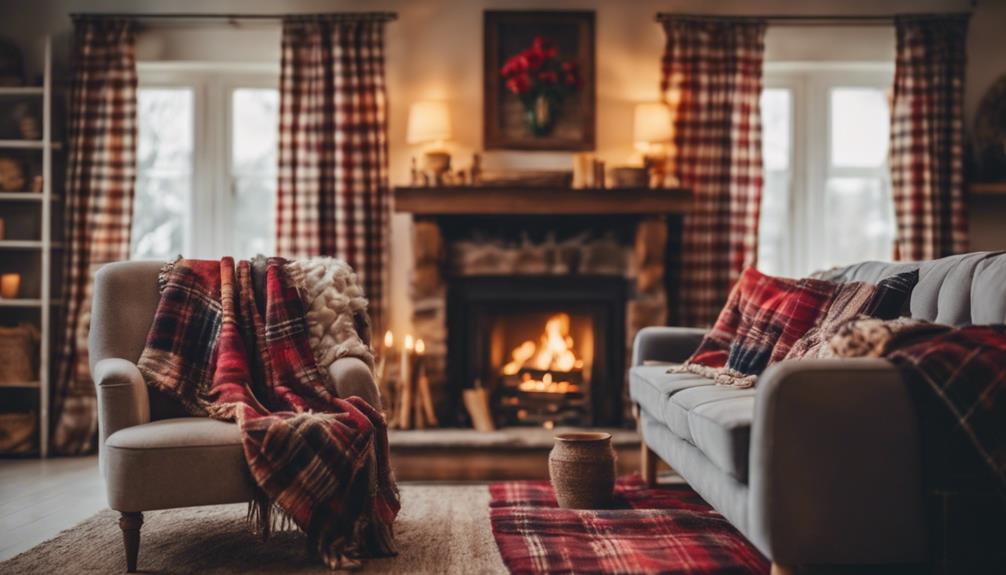
When deciding between floral and plaid for your country living room, consider the vibe you want to create. Floral patterns add warmth and vibrancy, making your space feel cheerful and inviting. On the other hand, plaid offers a more muted, rustic charm with grounded aesthetics. You can mix textures, using soft floral materials alongside sturdy plaid fabrics for balance. Don't forget to incorporate unique lighting and decorative elements like vintage items to enhance the overall feel. The choice really depends on your personal style and the atmosphere you wish to achieve in your home. Explore your options for a perfect blend!
Key Elements
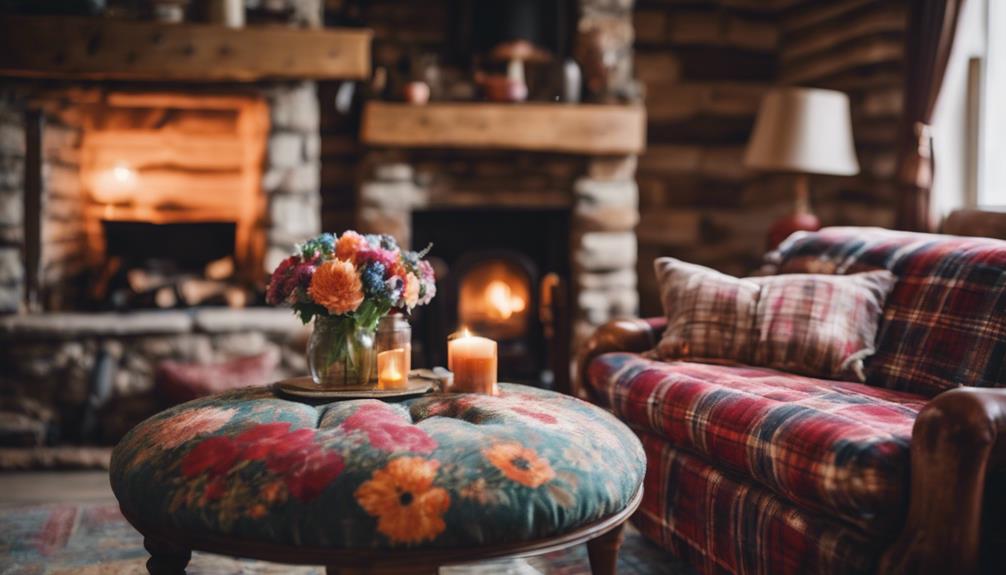
When choosing between floral and plaid for your country living room, consider the key elements of color scheme, materials, and textures.
Each pattern brings its own unique vibe to the space, so think about how they can harmonize with your existing decor.
Color Scheme
A well-chosen color scheme can seamlessly blend floral and plaid patterns, enhancing the cozy charm of your country living room. Floral patterns often bring a burst of warmth and vibrancy, creating a cheerful atmosphere. In contrast, plaid designs typically favor muted colors, lending a rustic feel that complements natural materials and earthy tones.
To achieve balance, consider incorporating warm neutrals and earthy colors, such as rich browns and muted greens. These shades not only ground the overall design but also allow floral accents to shine without overwhelming the space. For instance, a bright floral cushion can pop against a muted plaid sofa, creating visual interest while maintaining harmony.
When selecting a color scheme, make certain that the hues across both floral and plaid elements are cohesive. This approach fosters a seamless blend, preventing any clash between the lively florals and structured plaids.
Materials
Choosing the right materials is key to harmonizing floral and plaid patterns in your country living room, as each fabric type contributes to the overall aesthetic and comfort of the space.
Floral patterns often feature vibrant colors and intricate designs, typically crafted from soft materials like cotton or linen. These fabrics bring warmth and liveliness, making them perfect for soft furnishings like cushions and curtains.
On the other hand, plaid patterns provide a classic, cozy vibe, usually made from more durable materials such as wool or tweed. These fabrics add rustic charm and are ideal for heavier items like throws and upholstery, enhancing the traditional feel of your room.
When you consider wall treatments, floral wallpapers can create a cheerful backdrop, while plaid can lend a grounded, timeless look, especially in accent walls.
To achieve a balanced and inviting space, mix these materials thoughtfully. Use floral patterns to soften the boldness of plaid, ensuring that both styles complement each other.
Textures
To create a warm and inviting country living room, mixing a variety of textures—from soft cotton and wool to natural elements like wood and stone—plays an essential role in crafting a cozy atmosphere. Soft textiles like cotton or wool for upholstery not only provide comfort but also enhance the overall warmth of your space.
Incorporating natural materials, such as weathered wood and stone, contributes to the rustic charm that defines country living. You can achieve depth and visual interest by layering various textures, like chunky knit blankets paired with plaid pillows. This layering enhances the cozy atmosphere you're aiming for.
Vintage furniture pieces add unique textures and history to your decor, creating a personalized and inviting environment. Consider mixing finishes, like distressed metals alongside soft fabrics, to balance the rustic aesthetic while introducing a touch of modernity.
Essential Fixtures and Furniture
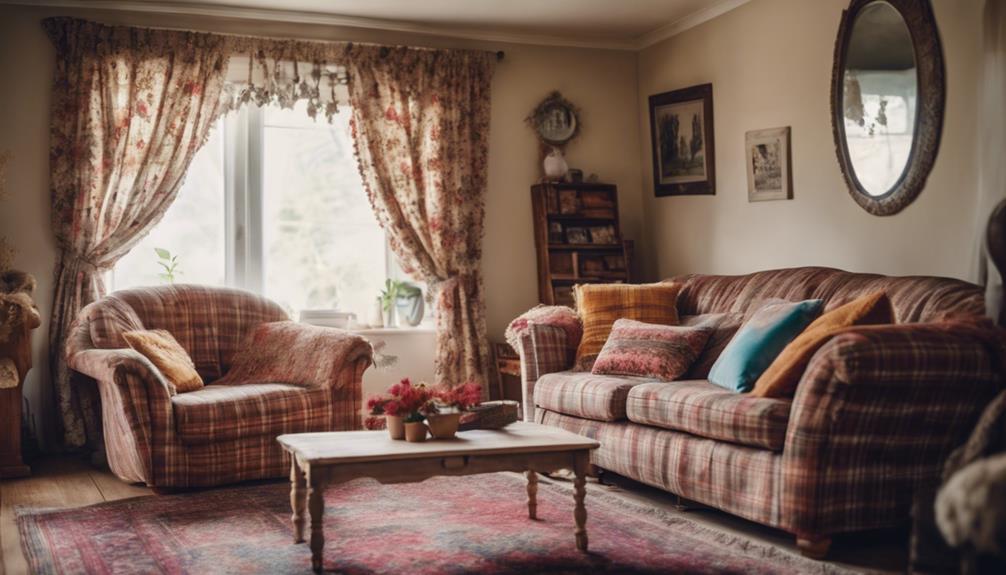
When it comes to essential fixtures and furniture for your country living room, you'll want to focus on key pieces that enhance the overall aesthetic.
A vintage farmhouse dining table, an antique sideboard with character, and a rustic farmhouse coffee table can create a warm and inviting atmosphere.
These elements not only complement floral or plaid designs but also reinforce the rustic charm you're aiming for.
Vintage Farmhouse Dining Table
A vintage farmhouse dining table adds a touch of rustic charm and durability to your country living room, making it an essential piece for both family meals and gatherings.
These tables often feature solid wood construction that emphasizes their durability while enhancing the rustic aesthetic of your space. With their distressed finishes, they not only provide a sense of history but also exude warmth, making your home feel cozy and inviting.
You'll find that vintage farmhouse tables come in various sizes, perfectly accommodating everything from intimate dinners to larger family gatherings. Their sturdy legs and unique design elements, like turned legs or trestle bases, enhance both functionality and style, ensuring they stand out in any country home.
Plus, incorporating a vintage farmhouse dining table into your decor allows you to mix and match with other traditional elements, such as mismatched chairs or colorful table settings, creating a welcoming atmosphere.
In essence, a vintage farmhouse dining table is more than just furniture; it's a centerpiece that brings people together, making it an indispensable addition to your country living room.
Antique Sideboard With Character
An antique sideboard often becomes the focal point of your country living room, offering both style and practical storage solutions. This piece of antique furniture can serve as a functional centerpiece, allowing you to store items while displaying vintage dishes or cherished family heirlooms. Its unique character often comes from distressed finishes and historical craftsmanship, which add a rustic touch that enhances the room's overall aesthetic.
Made from solid wood, many antique sideboards provide durability and a timeless appeal, perfectly complementing other natural materials in your decor. Selecting a sideboard with intricate carvings or distinctive hardware not only enhances the vintage style but also makes it a conversation starter for your guests.
Rustic Farmhouse Coffee Table
Building on the charm of an antique sideboard, a rustic farmhouse coffee table serves as a practical yet stylish centerpiece in your country living room. Typically crafted from reclaimed wood, these coffee tables emphasize sustainability while showcasing unique character in every piece. The distressed finish not only enhances the vintage aesthetic but also complements other elements within farmhouse interiors.
When choosing your coffee table, consider the size to guarantee it fits comfortably within your seating area. It should allow for easy access and flow, making your living space inviting. Many rustic farmhouse coffee tables come equipped with functional features like storage drawers or shelves, perfect for keeping your cozy area organized.
You can also personalize your choice with various styles, such as farmhouse chic or industrial farmhouse, allowing the coffee table to seamlessly blend with your overall decor. Whether you're enjoying a cup of coffee or entertaining guests, a rustic farmhouse coffee table provides both functionality and charm, making it an essential fixture in your country living room.
Lighting Ideas
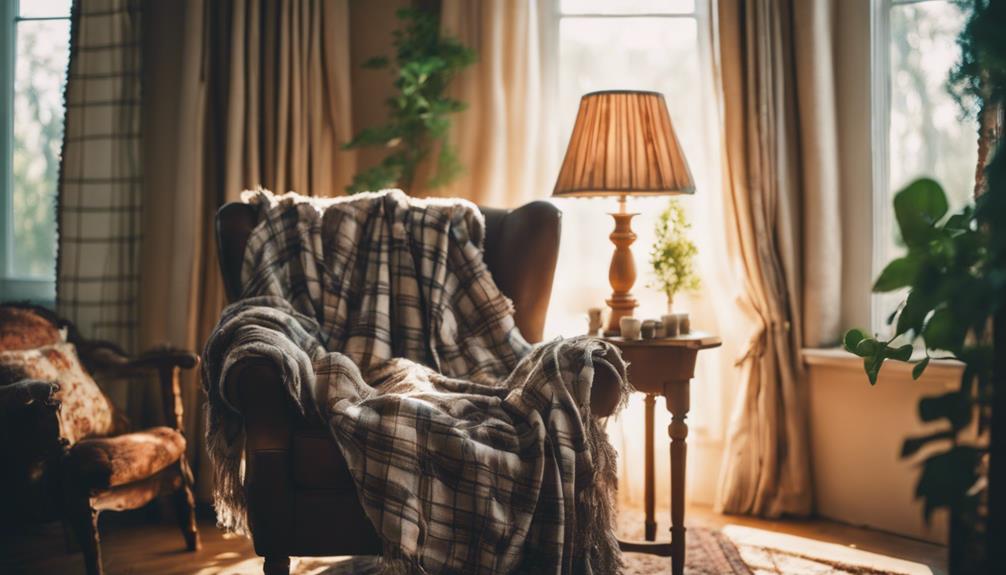
When it comes to lighting your country living room, think about incorporating rustic lanterns for that cozy ambiance.
Vintage Edison bulb fixtures and antique-style table lamps can add a touch of charm, while charming candle chandeliers create a warm glow for intimate gatherings.
Layering these elements will enhance the overall aesthetic and make your space feel inviting.
Rustic Lanterns for Ambient Lighting
Rustic lanterns create a warm, inviting glow that perfectly complements the natural materials and cozy decor of your country living room. These charming fixtures enhance ambient lighting by providing a soft radiance that makes your space feel welcoming and comfortable. You can find rustic lanterns in various styles, including wrought iron, wood, and glass, allowing you to choose options that resonate with your personal taste.
Hang them from ceilings to illuminate your room or place them on tables for added visual interest. Many rustic lanterns come equipped with flickering LED candles or traditional candle placements, giving you a safe yet authentic glow reminiscent of old-world charm. By incorporating these lanterns into your decor, you can create focal points that highlight architectural features like exposed beams or stone fireplaces.
Don't hesitate to mix sizes and styles of rustic lanterns; this adds depth and texture to your living room, helping create a layered and inviting atmosphere. With the right placement, rustic lanterns can transform your space into a cozy retreat, making it the perfect spot for relaxation and gatherings.
Vintage Edison Bulb Fixtures
Vintage Edison bulb fixtures effortlessly bring a nostalgic charm to your country living room, enhancing its inviting atmosphere with their warm glow and classic design.
These fixtures, featuring exposed filaments, emit a soft light that creates a cozy atmosphere perfect for relaxation or entertaining guests.
You'll find vintage Edison bulb fixtures in various styles, including pendant, chandelier, and wall sconces, making it easy to complement your space's rustic charm.
When strategically placed, they can serve as a focal point, drawing attention to your room's architectural features like exposed beams or rustic furnishings.
If you're looking for an eco-friendly option, consider energy-efficient LED Edison bulbs.
They maintain the vintage look while reducing energy consumption and extending bulb life, allowing you to enjoy the aesthetic without compromising on sustainability.
Incorporating these fixtures into your lighting design not only enhances the ambiance but also ties together diverse elements of your decor.
Whether you prefer a traditional or modern take on country style, vintage Edison bulb fixtures can elevate your living room, creating a warm and inviting space that reflects your personal taste.
Antique-style Table Lamps
While vintage Edison bulb fixtures set the mood, incorporating antique-style table lamps can further enhance the charm and sophistication of your country living room. These lamps often feature intricate designs and materials like brass, porcelain, or stained glass, adding a timeless elegance that complements rustic decor. Their unique shades, crafted from vintage fabrics or glass, can elevate the character of your space, offering decorating ideas that truly stand out.
Antique-style table lamps aren't just decorative; they provide both ambient and task lighting, helping to create a cozy atmosphere. Think about placing them on side tables or console tables to add warmth and functionality. When selecting the right lamps, pay attention to their height and scale in relation to your furniture to maintain a harmonious balance in your room.
Furthermore, these lamps showcase craftsmanship from different eras, making them conversation starters and focal points in your living room. By choosing antique-style table lamps, you'll not only illuminate your space but also infuse it with a touch of nature and history, enriching the overall ambiance of your country living room.
Charming Candle Chandeliers
Candle chandeliers can transform your country living room with their warm, inviting glow and charming designs that highlight natural materials and vintage decor. These fixtures are perfect for enhancing the rustic aesthetic of your space, providing a cozy ambiance that encourages gatherings and relaxation.
When you choose charming candle chandeliers, look for options featuring intricate designs, such as wrought iron or distressed wood. These elements add character and elegance, making your chandelier a stunning focal point. Opting for chandeliers that hold multiple candles guarantees your rustic living room is well-lit, creating an inviting atmosphere.
Consider varying the heights of your candle chandeliers to add visual interest and depth to your decor. This layering technique enhances the texture typical of country living rooms, making them feel more dynamic.
Decorative Elements
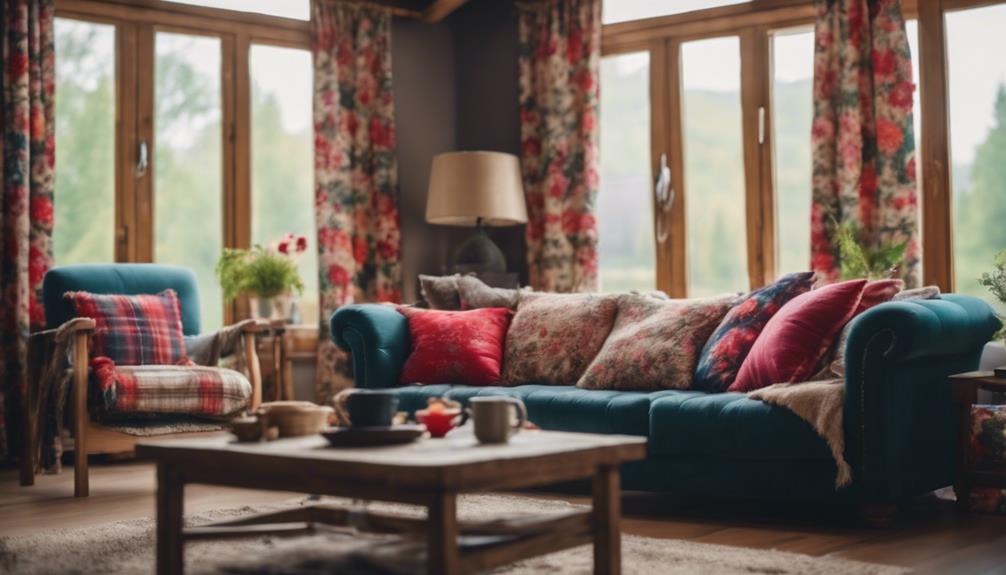
When it comes to decorative elements, think about incorporating handcrafted ceramic vases, vintage floral wall art, and woven wicker wall baskets.
These pieces not only enhance the country charm but also reflect your personal taste.
Handcrafted Ceramic Vase
How can handcrafted ceramic vases enhance the charm of your country living room? These unique decor pieces bring an artisanal charm that perfectly complements your rustic decor.
With their earthy glazes and textures, handcrafted ceramic vases introduce a natural feel that resonates with the warmth of your space.
You can use them as focal points by filling them with fresh flowers or dried arrangements, instantly adding color and life to the room. The beauty of these vases lies in their versatility; they come in various sizes, shapes, and colors, allowing you to create arrangements that reflect your individual style.
Incorporating handcrafted ceramic vases into your decor not only elevates the aesthetic but also adds a personal touch. Each piece showcases your appreciation for craftsmanship and supports local artisans, making your home feel more connected to the community.
Whether you opt for a single statement vase or a collection, these elements will enhance the overall ambiance of your country living room, making it a cozy retreat that tells your unique story.
Vintage Floral Wall Art
Vintage floral wall art adds a touch of nostalgia and warmth, making it a perfect focal point for your country living room. These art pieces often showcase intricate patterns and muted tones, which evoke tranquility and a connection to nature.
When you choose vintage floral wall art, you enhance the overall color palette of your space, allowing it to blend seamlessly with soft furnishings and wood accents. Incorporating these pieces into your decor not only complements rustic decor but also adds character and individuality to the room.
You can easily mix and match vintage floral art with other styles, like plaid or gingham, to create a layered and inviting aesthetic. This versatility allows you to express your personal style while maintaining a cozy atmosphere.
When selecting vintage floral wall art, consider how it reflects your tastes and the mood you want to create. By thoughtfully integrating these elements, you can transform your country living room into a warm, welcoming haven that feels uniquely yours.
Embrace the charm of vintage floral wall art, and let it breathe life into your decor!
Woven Wicker Wall Baskets
Woven wicker wall baskets bring a unique blend of texture and warmth to your country living room, instantly enhancing its cozy charm. These versatile decorative elements can serve dual purposes, acting as both storage solutions for items like magazines or throws and as stylish accents that complement rustic decor.
Available in various sizes and shapes, you can arrange woven wicker wall baskets in groupings to create an eye-catching focal point on a blank wall. This arrangement not only adds visual interest but also brings a sense of balance to the space. Incorporating natural materials like wicker helps connect your indoor area with nature, aligning perfectly with the essence of country living design principles.
Another advantage of woven wicker wall baskets is their adaptability. You can easily style them with seasonal decor, such as dried flowers or greenery, making them a dynamic addition to your living room decor.
Flooring
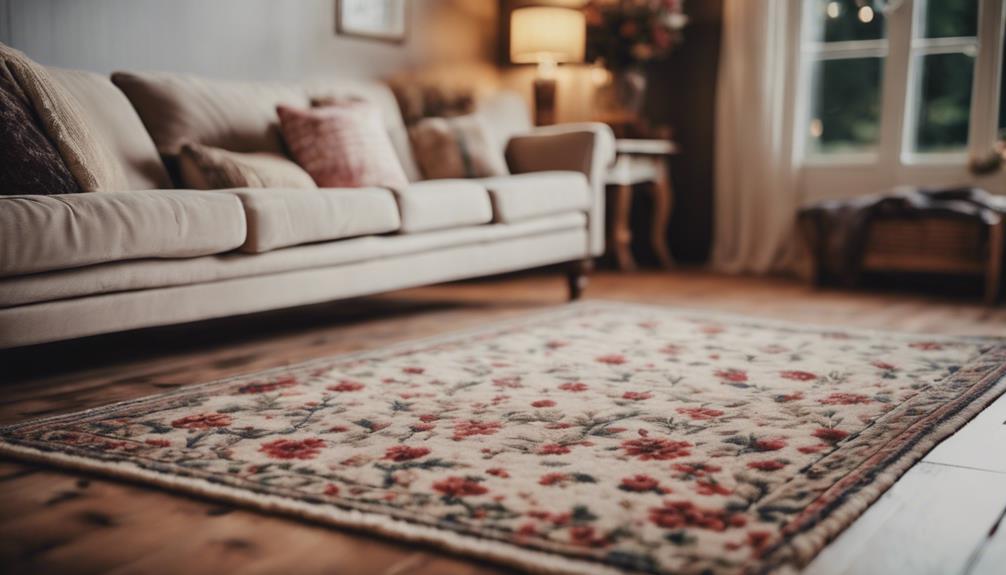
When it comes to flooring for your country living room, you can't go wrong with options like reclaimed barnwood plank or wide plank oak, both of which bring a rustic charm.
Hand-scraped maple hardwood offers a classic touch that pairs beautifully with floral and plaid patterns.
Choosing the right flooring will set the tone for your space, so consider your style carefully.
Reclaimed Barnwood Plank Flooring
Reclaimed barnwood plank flooring brings a unique blend of sustainability and rustic charm to your country living room, making it a standout choice for your home's aesthetic. This flooring option not only reduces waste but also infuses your space with character and history through its weathered wood appearance. Each plank showcases natural beauty with variations in color and texture, creating a cozy atmosphere that complements both floral and plaid design elements.
Choosing reclaimed barnwood means you're investing in durability. Its age and history often make it more resilient than new wood, ensuring it can withstand the everyday wear and tear of family life. Plus, the rustic vibe of reclaimed wood pairs beautifully with country living room decor, enhancing the overall warmth of your space.
Moreover, installing reclaimed barnwood flooring can increase your home's value. Buyers often seek authentic, rustic charm in country-style interiors, and this flooring delivers just that.
Wide Plank Oak Flooring
Wide plank oak flooring offers a perfect blend of durability and rustic elegance, making it an ideal choice for your country living room. This flooring type is known for its strength, perfect for high-traffic areas where family and friends gather. The natural grain patterns and rich color variations of oak enhance the rustic charm of your space, creating a warm and inviting atmosphere.
With widths ranging from 5 to 12 inches, wide plank oak flooring adds a sense of spaciousness and visual interest to your living room. You can easily incorporate this flooring into various country living room ideas, pairing it with wood accents to emphasize the natural elements in your decor. Plus, oak flooring comes in various stains and finishes, allowing you to customize the look to fit your desired aesthetic—whether you prefer a light farmhouse vibe or a dark, cozy retreat.
Maintenance is a breeze, too. Regular sweeping and occasional refinishing will keep your wide plank oak flooring looking stunning for years to come. In short, this flooring option perfectly balances beauty and practicality, making it a standout choice for your country living room.
Hand-scraped Maple Hardwood Flooring
Hand-scraped maple hardwood flooring brings a textured finish that enhances the rustic charm of your country living room, offering a stylish alternative to wide plank oak. This flooring's unique hand-scraped finish varies in depth and design, giving your space a personalized look that radiates character.
In country-style living, the fine, uniform grain pattern of maple naturally complements both floral and plaid decor, creating a cohesive aesthetic that ties your room together. Plus, maple is one of the hardest domestic hardwoods, making it a durable choice for high-traffic areas. You won't have to worry about wear and tear, ensuring your flooring looks great for years to come.
Maintaining hand-scraped maple flooring is straightforward. Regular sweeping keeps it clean, while occasional refinishing preserves its beauty and durability over time.
Choosing this type of flooring not only enhances the rustic appeal of your living space but also aligns with your practical needs. So, if you're aiming for a cozy, inviting atmosphere in your country living room, hand-scraped maple hardwood flooring might just be the perfect fit.
Conclusion
Ultimately, whether you choose floral or plaid for your country living room depends on your personal style and the vibe you want to create.
Floral patterns can bring a soft, romantic touch, while plaid adds a cozy, rustic feel.
Remember to balance your choice with essential fixtures, lighting, and decorative elements that enhance the overall look.
Whichever you pick, make sure it reflects your personality and makes your living space inviting and warm.
Enjoy decorating!
-

 Vetted1 month ago
Vetted1 month ago14 Best Personalized Father's Day Gifts for Your Husband – Show Him You Care
-

 Alfresco1 month ago
Alfresco1 month agoAlfresco Stacker Doors: Seamless Indoor-Outdoor Living!
-

 Craft and Textiles3 months ago
Craft and Textiles3 months ago15 Best Places to Buy Appliances for Your Home – Top Retailers Reviewed
-

 Decorative Throws3 months ago
Decorative Throws3 months agoIs It Better to Dry Clean Blankets?
-

 Tableware and Dining Accessories3 months ago
Tableware and Dining Accessories3 months agoWhat Is the Meaning of the Word Tableware
-

 Tableware and Dining Accessories3 months ago
Tableware and Dining Accessories3 months agoWhat Is the Hindi Meaning of Tableware
-

 Craft and Textiles3 months ago
Craft and Textiles3 months ago15 Best Cordless Mowers for Effortless Lawn Care – Top Picks of 2024
-

 Yarn3 months ago
Yarn3 months agoIs Yarn Natural or Manmade? Unravel the Truth























